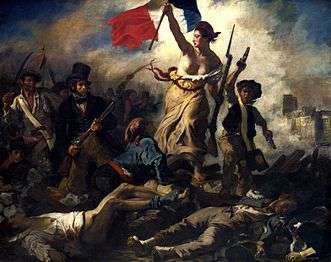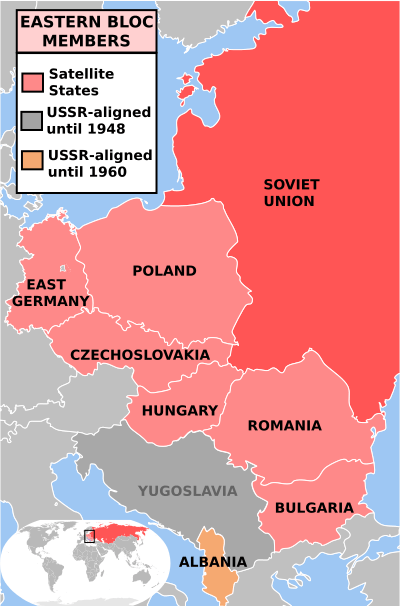Revolutions of 1989
| Revolutions of 1989 | ||
|---|---|---|
| Part of the Cold War | ||
|
The fall of the Berlin Wall in 1989 | ||
| Date |
9 March 1989 – 27 April 1992 (3 years, 1 month, 2 weeks and 4 days) | |
| Location |
Europe (especially Central Europe, then South-East and Eastern Europe) China Russia Communist countries in other parts of Europe and the world | |
| Causes | ||
| Goals | ||
| Methods | Protests, various | |
| Result |
| |
| Parties to the civil conflict | ||
| ||
| Also known as: Fall of Communism, Fall of Stalinism, Collapse of Communism, Collapse of Socialism, Fall of Socialism, Autumn of Nations, Fall of Nations, European Spring | ||

The Revolutions of 1989 were part of a revolutionary wave in the late 1980s and early 1990s that resulted in the end of communist rule in Central and Eastern Europe and beyond. The period is sometimes called the Autumn of Nations,[2][3][4][5][6] a play on the term "Spring of Nations" sometimes used to describe the Revolutions of 1848.
Leadup to revolution
By the late 1980s, people in the Caucasus and Baltic states were demanding more autonomy from Moscow, and the Kremlin was losing some of its control over certain regions and elements in the Soviet Union. In November 1988, Estonia issued a declaration of sovereignty,[7] which would eventually lead to other states making similar declarations of autonomy.
The Chernobyl disaster in April 1986 had major political and social effects that catalyzed or at least partially caused the revolutions of 1989. One political result of the disaster was greatly increased significance of the new Soviet policy of glasnost.[8][9] It is difficult to establish the total economic cost of the disaster. According to Mikhail Gorbachev, the Soviet Union spent 18 billion rubles (the equivalent of US$18 billion at that time) on containment and decontamination, virtually bankrupting itself.[10]
Collapse, from summer 1989 to fall 1991
Momentum towards full blown revolution began in Poland in 1989[11][12] and continued in Hungary, East Germany, Bulgaria, Czechoslovakia, and Romania. One feature common to most of these developments was the extensive use of campaigns of civil resistance, demonstrating popular opposition to the continuation of one-party rule and contributing to the pressure for change.[13] Romania was the only Eastern Bloc country whose people overthrew its Communist regime violently,[14] whereas the regimes in Romania and in some other countries inflicted violence on the population. The Tiananmen Square protests of 1989 failed to stimulate major political changes in China, but powerful images of courageous defiance during that protest helped to spark a precipitation of events in other parts of the globe. On the same day, 4 June, Solidarity won an overwhelming victory in a partially free election in Poland, leading to the peaceful fall of Communism in that country in the summer of 1989. Hungary dismantled its section of the physical Iron Curtain, leading to a mass exodus of East Germans through Hungary, which destabilized East Germany. This led to mass demonstrations in cities such as Leipzig and subsequently to the fall of the Berlin Wall, which served as the symbolic gateway to German reunification in 1990.
The Soviet Union was dissolved by the end of 1991, resulting in 14 countries (Armenia, Azerbaijan, Belarus, Estonia, Georgia, Kazakhstan, Kyrgyzstan, Latvia, Lithuania, Moldova, Tajikistan, Turkmenistan, Ukraine, and Uzbekistan) declaring their independence from the Soviet Union in the course of the years 1990–91. The rest of the Soviet Union, which constituted the bulk of the area, became Russia in December 1991. Communism was abandoned in Albania and Yugoslavia between 1990 and 1992. By 1992, Yugoslavia split into the five successor states of Bosnia and Herzegovina, Croatia, the Macedonia, Slovenia, and the Federal Republic of Yugoslavia, which was later renamed Serbia and Montenegro and eventually split into two states, Serbia and Montenegro. Serbia was then further split with the breakaway of the partially recognized state of Kosovo. Czechoslovakia was dissolved three years after the end of Communist rule, splitting peacefully into the Czech Republic and Slovakia in 1992.[15] The impact was felt in dozens of Socialist countries. Communism was abandoned in countries such as Cambodia, Ethiopia, Mongolia (which democratically re-elected a Communist government that ran the country until 1996), and South Yemen. The collapse of Communism (and of the Soviet Union) led commentators to declare the end of the Cold War.
During the adoption of varying forms of market economy there was initially a general decline in living standards.[16] Political reforms were varied, but in only five countries were Communist parties able to keep for themselves a monopoly on power: China, Cuba, North Korea, Laos, and Vietnam. Many Communist and Socialist organisations in the West turned their guiding principles over to social democracy. Communist parties in Italy and San Marino suffered, and the renewal of the Italian political class took place in the early 1990s. The European political landscape was drastically changed, with numerous Eastern Bloc countries joining NATO and the European Union, resulting in stronger economic and social integration.
Regime changes outside of Eastern Europe
In February 1986, in one of the first peaceful, mass-movement revolutions against a dictatorship, the People Power Revolution in the Philippines peacefully overthrew dictator Ferdinand Marcos and inaugurated Cory Aquino as president.
The domino effect of the revolutions of 1989 affected other regimes as well. The South African apartheid regime and Pinochet's military dictatorship in Chile were gradually dismantled during the 1990s as the West withdrew their funding and diplomatic support. Argentina, Ghana, Indonesia, Nicaragua, South Korea, Suriname, Republic of China (Taiwan), and North and South Yemen, among many others elected democratic governments.
Exact tallies of the number of democracies vary depending on the criteria used for assessment, but by some measures by the late 1990s there are well over 100 democracies in the world following, a marked increase in just a few decades.
Background
Development of the Communist Bloc

Ideas of Socialism had been gaining momentum among working class citizens of the world since the 19th century. These culminated in the early 20th century when several countries and subsequent nations formed their own Communist Parties. Many of the countries involved had hierarchical structures with monarchic governments and aristocratic social structures with an established nobility. Socialism was economically undesirable within the circles of the ruling classes (which had begun to include industrial business leaders), in the late 19th/early 20th century states; as such, Communist ideology was repressed – its champions suffered persecution while the nation on the whole was discouraged from adopting the mindset. This had been the practice even in the states which identified as exercising a multi-party system.
The Russian Revolution of 1917 saw the multi-ethnic Soviets overturn a previously nationalist czarist state. The Bolsheviks comprised ethnicities of all entities which would compose the Soviet Union throughout its phases.
During the interwar period, Communism had been on the rise in many parts of the world (e.g. in the Kingdom of Yugoslavia, it had grown popular in the urban areas throughout the 1920s). This led to a series of purges in many countries to stifle the movement.
Just as Communism had at some stage grown popular throughout the entities of Central and Eastern Europe, its image had also begun to tarnish at a later time all within the interwar period. As Socialist activists stepped up their campaigns against their oppressor regimes, they resorted to violence (including bombings and various other killings) to achieve their goal: this led large parts of the previously pro-Communist populace to lose interest in the ideology. A Communist presence forever remained in place however, but reduced from its earlier size.
In the early stages of World War II Nazi Germany invaded and occupied the countries of Eastern Europe, with the agreement of the USSR. Germany then turned against and invaded the USSR: the battles of this Eastern Front were the largest in history. The USSR perforce became a member of the Allies. The USSR fought the Germans to a standstill and finally began driving them back, reaching Berlin before the end of the war. Nazi ideology was violently opposed to Communism, and the Nazis brutally suppressed the Communist movements in the occupied countries. The Communists played a large part in the resistance to the Nazis in these countries. As the Soviets forced the Germans back, they assumed temporary control of these devastated areas. Earlier in the war in conferences at Tehran and Yalta, the allies had agreed that central and eastern Europe would be in the "Soviet sphere of political influence."
After World War II the Soviets brought into power various Communist parties who were loyal to Moscow. The Soviets retained troops throughout the territories they had occupied. The Cold War saw these states, bound together by the Warsaw Pact, have continuing tensions with the capitalist west symbolized by NATO. Mao Zedong established communism in China in 1949.
During the Hungarian Revolution of 1956, a spontaneous nationwide anti-authoritarian revolt, the Soviet Union invaded Hungary to assert control. In 1968, the USSR repressed the Prague Spring by organizing the Warsaw Pact invasion of Czechoslovakia.
Emergence of Solidarity in Poland
Labour turmoil in Poland during 1980 had led to the formation of the independent trade union, Solidarity, led by Lech Wałęsa, which over time became a political force. On 13 December 1981, Communist leader Wojciech Jaruzelski started a crack-down on Solidarity, declaring martial law in Poland, suspending the union, and temporarily imprisoning all of its leaders.
Mikhail Gorbachev
Although several Eastern bloc countries had attempted some abortive, limited economic and political reform since the 1950s (Hungarian Revolution of 1956, Prague Spring of 1968), the ascension of reform-minded Soviet leader Mikhail Gorbachev in 1985 signaled the trend toward greater liberalization. During the mid-1980s, a younger generation of Soviet apparatchiks, led by Gorbachev, began advocating fundamental reform in order to reverse years of Brezhnev stagnation. The Soviet Union was facing a period of severe economic decline and needed Western technology and credits to make up for its increasing backwardness. The costs of maintaining its empire – the military, KGB, subsidies to foreign client states – further strained the moribund Soviet economy.
The first signs of major reform came in 1986 when Gorbachev launched a policy of glasnost (openness) in the Soviet Union, and emphasized the need for perestroika (economic restructuring). By the spring of 1989, the Soviet Union had not only experienced lively media debate, but had also held its first multi-candidate elections in the newly established Congress of People's Deputies. Though glasnost advocated openness and political criticism, at the time, it was only permitted in accordance with the political views of the Communists. The general public in the Eastern bloc were still threatened by secret police and political repression.
Moscow's largest obstacle to improved political and economic relations with the Western powers remained the Iron Curtain that existed between East and West. As long as the specter of Soviet military intervention loomed over Central, South-East and Eastern Europe, it seemed unlikely that Moscow could attract the Western economic support needed to finance the country's restructuring. Gorbachev urged his Central and South-East European counterparts to imitate perestroika and glasnost in their own countries. However, while reformists in Hungary and Poland were emboldened by the force of liberalization spreading from East to West, other Eastern bloc countries remained openly skeptical and demonstrated aversion to reform. Past experiences had demonstrated that although reform in the Soviet Union was manageable, the pressure for change in Central and South-East Europe had the potential to become uncontrollable. These regimes owed their creation and continued survival to Soviet-style authoritarianism, backed by Soviet military power and subsidies. Believing Gorbachev's reform initiatives would be short-lived, orthodox Communist rulers like East Germany's Erich Honecker, Bulgaria's Todor Zhivkov, Czechoslovakia's Gustáv Husák, and Romania's Nicolae Ceauşescu obstinately ignored the calls for change.[17] "When your neighbor puts up new wallpaper, it doesn't mean you have to too," declared one East German politburo member.[18]
Solidarity's impact grows

Throughout the mid-1980s, Solidarity persisted solely as an underground organization, supported by the Catholic Church. However, by the late 1980s, Solidarity became sufficiently strong to frustrate Jaruzelski's attempts at reform, and nationwide strikes in 1988 forced the government to open a dialogue with Solidarity. On 9 March 1989, both sides agreed to a bicameral legislature called the National Assembly. The already existing Sejm would become the lower house. The Senate would be elected by the people. Traditionally a ceremonial office, the presidency was given more powers[19] (Polish Round Table Agreement).
By 1989, the Soviet Union had repealed the Brezhnev Doctrine in favor of non-intervention in the internal affairs of its Warsaw Pact allies, termed the Sinatra Doctrine in a joking reference to the Frank Sinatra song "My Way". Poland became the first Warsaw Pact state country to break free of Soviet domination. Taking notice from Poland, Hungary was next to follow.
National political movements
 People's Republic of China: Tiananmen Square protests
People's Republic of China: Tiananmen Square protests
New Chinese leader Deng Xiaoping (in office 1982–87) developed the concept of Socialism with Chinese characteristics, local market economy, around 1984, but the policy stalled.[20]
The first Chinese student demonstrations, which directly preceded the Beijing protests of 1989, took place in December 1986 in Hefei. The students called for campus elections, the chance to study abroad and greater availability of Western pop culture. Their protests took advantage of the loosening political atmosphere and included rallies against the slow pace of reform. Chairman Hu Yaobang, a protégé of Deng Xiaoping and a leading advocate of reform, was blamed for the protests and forced to resign as the CCP general secretary in January 1987. In the "Anti Bourgeois Liberalization Campaign", Hu would be further denounced.
The Tiananmen Square protests were sparked by the death of Hu Yaobang on 15 April 1989. By the eve of Hu's state funeral, some 100,000 students had gathered at Tiananmen square to observe it; however, no leaders emerged from the Great Hall. The movement lasted for seven weeks.[21]
Gorbachev's visit to China on 15 May during the protests brought many foreign news agencies to Beijing, and their sympathetic portrayals of the protesters helped galvanize a spirit of liberation among the Central, South-East and Eastern Europeans who were watching. The Chinese leadership, particularly Communist Party general secretary Zhao Ziyang, having begun earlier than the Soviets to radically reform the economy, was open to political reform, but not at the cost of a potential return to the disorder of the Cultural Revolution.
The movement lasted from Hu's death on 15 April until tanks rolled into Tiananmen Square on 4 June 1989. In Beijing, the military response to the protest by the PRC government left many civilians in charge of clearing the square of the dead and severely injured. The exact number of casualties is not known and many different estimates exist.
On 7 July 1989 President Mikhail Gorbachev implicitly renounced the use of force against other Soviet-bloc nations. Speaking to members of the 23-nation Council of Europe, Mr. Gorbachev made no direct reference to the so-called Brezhnev Doctrine, under which Moscow has asserted the right to use force to prevent a Warsaw Pact member from leaving the Communist fold, but stated 'Any interference in domestic affairs and any attempts to restrict the sovereignty of states – friends, allies or any others – are inadmissible'.[22]
 Poland
Poland
A wave of strikes hit Poland in April and May 1988, and a second wave began on 15 August that year when a strike broke out at the July Manifesto coal mine in Jastrzębie-Zdrój, the workers demanding the re-legalisation of Solidarity. Over the next few days, sixteen other mines went on strike followed by a number of shipyards, including on 22 August, the Gdansk Shipyard, famous as the epicentre of the 1980 industrial unrest that spawned Solidarity.[23] On 31 August 1988 Lech Wałęsa, the leader of Solidarity, was invited to Warsaw by the Communist authorities, who had finally agreed to talks.[24] On 18 January 1989 at a stormy session of the Tenth Plenary Session of the ruling United Workers' Party, General Wojciech Jaruzelski, the First Secretary, managed to get party backing for formal negotiations with Solidarity leading to its future legalisation – although this was achieved only by threatening the resignation of the entire party leadership if thwarted.[25] On 6 February 1989 formal Round Table discussions began in the Hall of Columns in Warsaw. On 4 April 1989 the historic Round Table Agreement was signed legalising Solidarity and setting up partly free parliamentary elections to be held on 4 June 1989 (incidentally, the day following the midnight crackdown on Chinese protesters in Tiananmen Square). A political earthquake followed. The victory of Solidarity surpassed all predictions. Solidarity candidates captured all the seats they were allowed to compete for in the Sejm, while in the Senate they captured 99 out of the 100 available seats (with the one remaining seat taken by an independent candidate). At the same time, many prominent Communist candidates failed to gain even the minimum number of votes required to capture the seats that were reserved for them.
On 15 August 1989, the Communists' two longtime coalition partners, the United People's Party (ZSL) and the Democratic Party (SD), broke their alliance with the PZPR and announced their support for Solidarity. The last Communist Prime Minister of Poland, General Czesław Kiszczak, said he would resign to allow a non-Communist to form an administration.[26] As Solidarity was the only other political grouping that could possibly form a government, it was virtually assured that a Solidarity member would become prime minister. On 19 August 1989, in a stunning watershed moment, Tadeusz Mazowiecki, an anti-Communist editor, Solidarity supporter, and devout Catholic, was nominated as Prime Minister of Poland – and the Soviet Union voiced no protest, despite calls from hard-line Romanian dictator Nicolae Ceaușescu for the Warsaw Pact to intervene militarily to 'save socialism' as it had in Prague in 1968.[27] Five days later, on 24 August 1989, Poland's Parliament ended more than 40 years of one-party rule by making Mazowiecki the country's first non-Communist Prime Minister since the early postwar years. In a tense Parliament, Mazowiecki received 378 votes, with 4 against and 41 abstentions.[28] On 13 September 1989 a new non-Communist government was approved by parliament, the first of its kind in the Eastern Bloc.[29] On 17 November 1989 the statue of Felix Dzerzhinsky, Polish founder of the Cheka and symbol of Communist oppression, was torn down in Bank Square, Warsaw.[30] On 29 December 1989 the Sejm amended the constitution to change the official name of the country from the People's Republic of Poland to the Republic of Poland. The communist Polish United Workers' Party dissolved itself on 29 January 1990 and transformed itself into the Social Democracy of the Republic of Poland.[31]
In 1990, Jaruzelski resigned as Poland's president and was succeeded by Wałęsa, who won the 1990 presidential elections[31] held in two rounds on 25 November and 9 December. Wałęsa's inauguration as president on 21 December 1990 is thought by many to be the formal end of the Communist People's Republic of Poland and the beginning of the modern Republic of Poland. The Warsaw Pact was dissolved on 1 July 1991. On 27 October 1991 the first entirely free Polish parliamentary elections since 1945 took place. This completed Poland's transition from Communist Party rule to a Western-style liberal democratic political system. The last Russian troops left Poland on 18 September 1993.[31]
 Hungary
Hungary
Following Poland's lead, Hungary was next to switch to a non-Communist government. Although Hungary had achieved some lasting economic reforms and limited political liberalization during the 1980s, major reforms only occurred following the replacement of János Kádár as General Secretary of the Communist Party on 23 May 1988 with Károly Grósz.[32] On 24 November 1988 Miklós Németh was appointed Prime Minister. On 12 January 1989, the Parliament adopted a "democracy package", which included trade union pluralism; freedom of association, assembly, and the press; a new electoral law; and a radical revision of the constitution, among others.[33] On 29 January 1989, contradicting the official view of history held for more than 30 years, a member of the ruling Politburo Imre Pozsgay declared that Hungary's 1956 rebellion is a popular uprising rather than a foreign-instigated attempt at counterrevolution.[34] Mass demonstrations on 15 March, the National Day, persuaded the regime to begin negotiations with the emergent non-Communist political forces. Round Table talks began on 22 April and continued until the Round Table agreement was signed on 18 September. The talks involved the Communists (MSzMP) and the newly emerging independent political forces Fidesz, the Alliance of Free Democrats (SzDSz), the Hungarian Democratic Forum (MDF), the Independent Smallholders' Party, the Hungarian People's Party, the Endre Bajcsy-Zsilinszky Society, and the Democratic Trade Union of Scientific Workers. At a later stage the Democratic Confederation of Free Trade Unions and the Christian Democratic People's Party (KDNP) were invited.[35] It was at the talks that a number of Hungary's future political leaders emerged, including László Sólyom, József Antall, György Szabad, Péter Tölgyessy and Viktor Orbán.[36]
On 2 May 1989, the first visible cracks in the Iron Curtain appeared when Hungary began dismantling its 240-kilometre (150 mi) long border fence with Austria.[37] This increasingly destabilized the GDR and Czechoslovakia over the summer and autumn as thousands of their citizens illegally crossed over to the West through the Hungarian-Austrian border. On 1 June 1989 the Communist Party admitted that former Prime Minister Imre Nagy, hanged for treason for his role in the 1956 Hungarian uprising, was executed illegally after a show trial.[38] On 16 June 1989 Nagy was given a solemn funeral on Budapest's largest square in front of crowds of at least 100,000, followed by a hero's burial.[39]
The Round Table agreement of 18 September encompassed six draft laws that covered an overhaul of the Constitution, establishment of a Constitutional Court, the functioning and management of political parties, multiparty elections for National Assembly deputies, the penal code and the law on penal procedures (the last two changes represented an additional separation of the Party from the state apparatus).[40][41] The electoral system was a compromise: about half of the deputies would be elected proportionally and half by the majoritarian system.[42] A weak presidency was also agreed upon, but no consensus was attained on who should elect the president (parliament or the people) and when this election should occur (before or after parliamentary elections). On 7 October 1989, the Communist Party at its last congress re-established itself as the Hungarian Socialist Party.[43] In a historic session from 16 to 20 October, the parliament adopted legislation providing for multi-party parliamentary elections and a direct presidential election, which took place on March 24, 1990.[44] The legislation transformed Hungary from a People's Republic into the Republic of Hungary, guaranteed human and civil rights, and created an institutional structure that ensured separation of powers among the judicial, legislative, and executive branches of government.[45] The Soviet military occupation of Hungary, which had persisted since World War II, ended on 19 June 1991.
 East Germany
East Germany
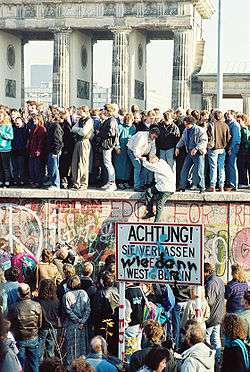
On 2 May 1989, Hungary started dismantling its barbed wire border with Austria, opening a large hole through the Iron Curtain to the West that was used by a growing number of East Germans. By the end of September 1989, more than 30,000 East Germans had escaped to the West before the GDR denied travel to Hungary, leaving the CSSR (Czechoslovakia) as the only neighboring state where East Germans could escape to. Thousands of East Germans tried to reach the West by occupying the West German diplomatic facilities in other Central and Eastern European capitals, notably the Prague Embassy and the Hungarian Embassy where thousands camped in the muddy garden from August to November waiting for German political reform. The GDR closed the border to the CSSR on 3 October, thereby isolating itself from all neighbors. Having been shut off from their last chance for escape, an increasing number of East Germans participated in the Monday demonstrations in Leipzig on 4, 11, and 18 September, each attracting 1,200 to 1,500 demonstrators; many were arrested and beaten. However, the people refused to be intimidated. On 25 September, the protests attracted 8,000 demonstrators.
After the fifth successive Monday demonstration in Leipzig on 2 October attracted 10,000 protesters, Socialist Unity Party (SED) leader Erich Honecker issued a shoot and kill order to the military.[46] Communists prepared a huge police, militia, Stasi, and work-combat troop presence and there were rumors a Tiananmen Square-style massacre was being planned for the following Monday's demonstration on 9 October.[47]
On 6 and 7 October, Mikhail Gorbachev visited East Germany to mark the 40th anniversary of the German Democratic Republic, and urged the East German leadership to accept reform. A famous quote of his is rendered in German as "Wer zu spät kommt, den bestraft das Leben" (He who is too late is punished by life). However, Honecker remained opposed to internal reform, with his regime even going so far as forbidding the circulation of Soviet publications that it viewed as subversive.
In spite of rumours that the Communists were planning a massacre on 9 October 70,000 citizens demonstrated in Leipzig that Monday, the authorities on the ground refused to open fire. This victory of the people facing down the Communists guns encouraged more and more citizens to take to the streets. The following Monday on 16 October 120,000 people demonstrated on the streets of Leipzig.
Erich Honecker had hoped that the Soviets would enter the GDR, as by the Warsaw Pact, and restore the communist government and suppress the civilian protests. By 1990 the Soviet Government deemed it impractical for the Soviet Union to continue holding its grasp on the Eastern Bloc, and so it took a neutral stance regarding the events happening in East Germany. Faced with this ongoing civil unrest, the SED deposed Honecker on 18 October and replaced him with the number-two-man in the regime, Egon Krenz. However, the demonstrations kept growing – on Monday 23 October the Leipzig protesters numbered 300,000 and remained as large the following week. The border to Czechoslovakia was opened again on 1 November, but the Czechoslovak authorities soon let all East Germans travel directly to West Germany without further bureaucratic ado, thus lifting their part of the Iron Curtain on 3 November. On 4 November the authorities decided to authorize a demonstration in Berlin and were faced with the Alexanderplatz demonstration where half a million citizens converged on the capital demanding freedom in the biggest protest the GDR ever witnessed. Unable to stem the ensuing flow of refugees to the West through Czechoslovakia, the East German authorities eventually caved in to public pressure by allowing East German citizens to enter West Berlin and West Germany directly, via existing border points, on 9 November 1989, without having properly briefed the border guards. Triggered by the erratic words of regime spokesman Günter Schabowski in a TV press conference, stating that the planned changes were in effect "immediately, without delay," hundreds of thousands of people took advantage of the opportunity. The guards were quickly overwhelmed by the growing crowds of people demanding to be let out into West Berlin. After receiving no feedback from their superiors, the guards, unwilling to use force, relented and opened the gates to West Berlin. Soon new crossing points were forced open in the Berlin Wall by the people, and sections of the wall were literally torn down as this symbol of oppression was overwhelmed. The bewildered guards were unaware of what was happening, and meekly stood by as the East Germans took to the wall with hammers and chisels.
On 13 November GDR Prime Minister Willi Stoph and his entire cabinet resigned. A new government was formed under a considerably more liberal Communist, Hans Modrow. On 1 December the Volkskammer removed the SED's leading role from the constitution of the GDR. On 3 December Krenz resigned as leader of the SED; he resigned as head of state three days later. On 7 December Round Table talks opened between the SED and other political parties. On 16 December 1989 the SED was dissolved and refounded as the SED-PDS, abandoning Marxism-Leninism and becoming a mainstream democratic socialist party.
On 15 January 1990 the Stasi's headquarters was stormed by protesters. Modrow became the de facto leader of East Germany until free elections were held on 18 March 1990—the first held in that part of Germany since 1933. The SED, renamed the Party of Democratic Socialism, was heavily defeated. Lothar de Maizière of the East German Christian Democratic Union became Prime Minister on 4 April 1990 on a platform of speedy reunification with the West. The two Germanies were reunified on 3 October 1990.
The Kremlin's willingness to abandon such a strategically vital ally marked a dramatic shift by the Soviet superpower and a fundamental paradigm change in international relations, which until 1989 had been dominated by the East-West divide running through Berlin itself. The last Russian troops left the territory of the former GDR, now part of a reunited Federal Republic of Germany, on 1 September 1994.
 Czechoslovakia
Czechoslovakia
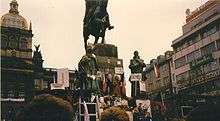
The "Velvet Revolution" was a non-violent revolution in Czechoslovakia that saw the overthrow of the Communist government. On 17 November 1989 (Friday), riot police suppressed a peaceful student demonstration in Prague, although controversy continues over whether anyone died that night. That event sparked a series of popular demonstrations from 19 November to late December. By 20 November the number of peaceful protesters assembled in Prague had swelled from 200,000 the previous day to an estimated half-million. Five days later, the Letná Square held 800,000 protesters.[48] On 24 November, the entire Communist Party leadership, including general secretary Miloš Jakeš, resigned. A two-hour general strike, involving all citizens of Czechoslovakia, was successfully held on 27 November.
With the collapse of other Communist governments, and increasing street protests, the Communist Party of Czechoslovakia announced on 28 November 1989 that it would relinquish power and dismantle the single-party state. Barbed wire and other obstructions were removed from the border with West Germany and Austria in early December. On 10 December, President Gustáv Husák appointed the first largely non-Communist government in Czechoslovakia since 1948, and resigned. Alexander Dubček was elected speaker of the federal parliament on 28 December and Václav Havel the President of Czechoslovakia on 29 December 1989. In June 1990 Czechoslovakia held its first democratic elections since 1946. On 27 June 1991 the last Soviet troops were withdrawn from Czechoslovakia.[49]
.svg.png) Bulgaria
Bulgaria
In October and November 1989 demonstrations on ecological issues were staged in Sofia, where demands for political reform were also voiced. The demonstrations were suppressed, but on 10 November 1989 – the day after the Berlin Wall was breached – Bulgaria's long-serving leader Todor Zhivkov was ousted by his Politburo. He was succeeded by a considerably more liberal Communist, former foreign minister Petar Mladenov. Moscow apparently approved the leadership change, as Zhivkov had been opposed to Gorbachev's policies. The new regime immediately repealed restrictions on free speech and assembly, which led to the first mass demonstration on 17 November, as well as the formation of anti-communist movements. Nine of them united as the Union of Democratic Forces (UDF) on 7 December.[50] The UDF was not satisfied with Zhivkov's ouster, and demanded additional democratic reforms, most importantly the removal of the constitutionally mandated leading role of the Bulgarian Communist Party.
Mladenov announced on 11 December 1989 that the Communist Party would abandon its monopoly on power, and that multiparty elections would be held the following year. In February 1990, the Bulgarian legislature deleted the portion of the constitution about the "leading role" of the Communist Party. Eventually, it was decided that a round table on the Polish model would be held in 1990 and elections held by June 1990. The round table took place from 3 January to 14 May 1990, at which an agreement was reached on the transition to democracy. The Communist Party abandoned Marxism-Leninism in April 1990 and renamed itself as the Bulgarian Socialist Party. In June 1990 the first free elections since 1931 were held, won by the Bulgarian Socialist Party.
.svg.png) Romania
Romania
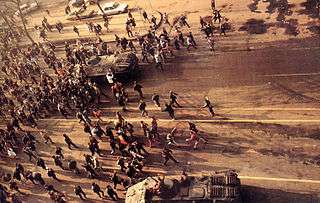
After having survived the Braşov Rebellion in 1987, Nicolae Ceauşescu was re-elected for another five years as leader of the Romanian Communist Party (PCR) in November 1989, signalling that he intended to ride out the anti-Communist uprisings sweeping the rest of Europe. As Ceauşescu prepared to go on a state visit to Iran, his Securitate ordered the arrest and exile of a local Hungarian Calvinist minister, László Tőkés, on 16 December, for sermons offending the regime. Tőkés was seized, but only after serious rioting erupted. Timişoara was the first city to react, on 16 December, and civil unrest continued for 5 days.
Returning from Iran, Ceauşescu ordered a mass rally in his support outside Communist Party headquarters in Bucharest on 21 December. However, to his shock, the crowd booed and jeered him as he spoke. Years of repressed dissatisfaction boiled to the surface throughout the Romanian populace and even among elements in Ceauşescu's own government, and the demonstrations spread throughout the country.
At first the security forces obeyed Ceauşescu's orders to shoot protesters. However, on the morning of 22 December, the Romanian military suddenly changed sides. This came after it was announced that defense minister Vasile Milea had committed suicide after being unmasked as a traitor. Believing Milea had actually been murdered, the rank-and-file soldiers went over virtually en masse to the revolution.[51] Army tanks began moving towards the Central Committee building with crowds swarming alongside them. The rioters forced open the doors of the Central Committee building in an attempt to capture Ceauşescu and his wife, Elena, coming within a few meters of the couple. However, they managed to escape via a helicopter waiting for them on the roof of the building. The revolution resulted in 1,104 deaths. Unlike its kindred parties in the Warsaw Pact, the PCR simply melted away; no present-day Romanian party claiming to be its successor has ever been elected to the legislature since the change of system.
Although elation followed the flight of the Ceauşescus, uncertainty surrounded their fate. On Christmas Day, Romanian television showed the Ceauşescus facing a hasty trial, and then undergoing summary execution. An interim National Salvation Front Council led by Ion Iliescu took over and announced elections for April 1990 – the first free elections held in Romania since 1937. However, they were postponed until 20 May 1990.
 Yugoslavia
Yugoslavia
The Socialist Federal Republic of Yugoslavia was not a part of the Warsaw Pact but pursued its own version of "Communism" under Josip Broz Tito. It was a multi-ethnic state which Tito was able to maintain through a doctrine of "Brotherhood and unity", but tensions between ethnicities began to escalate with the so-called Croatian Spring of 1970–71, a movement for greater Croatian autonomy, which was suppressed. In 1974 there followed constitutional changes, and the 1974 Yugoslav Constitution devolved some of the federal powers to the constituent republics and provinces. After Tito's death in 1980 ethnic tensions grew, first in Albanian-majority SAP Kosovo with the 1981 protests in Kosovo. In late 1980s Serbian leader Slobodan Milošević used the Kosovo crisis to stoke up Serb nationalism and attempt to consolidate and dominate the country, which alienated the other ethnic groups.
Parallel to the same process, SR Slovenia witnessed a policy of gradual liberalization since 1984, somewhat similar to the Soviet Perestroika. This provoked tensions between the League of Communists of Slovenia on one side, and the central Yugoslav Party and the federal army on the other side. By the late 1980s, many civil society groups were pushing towards democratization, while widening the space for cultural plurality. In 1987 and 1988, a series of clashes between the emerging civil society and the Communist regime culminated with the so-called Slovene Spring, a mass movement for democratic reforms. The Committee for the Defence of Human Rights was established as the platform of all major non-Communist political movements. By early 1989, several anti-Communist political parties were already openly functioning, challenging the hegemony of the Slovenian Communists. Soon, the Slovenian Communists, pressured by their own civil society, came into conflict with the Serbian Communist leadership.
In January 1990, an extraordinary Congress of the League of Communists of Yugoslavia was called in order to settle the disputes among its constituent parties. Faced with being completely outnumbered, the Slovenian and Croatian Communists walked out of the Congress on 23 January 1990, thus effectively bringing to an end the Yugoslav Communist Party. Both parties of the two western republics negotiated free multi-party elections with their own opposition movements.
On 8 April 1990, the democratic and anti-Yugoslav DEMOS coalition won the elections in Slovenia, while on 24 April 1990 the Croatian elections witnessed the landslide victory of the nationalist Croatian Democratic Union (HDZ) led by Franjo Tuđman. The results were much more balanced in Bosnia and Herzegovina and Macedonia in November 1990, while the parliamentary and presidential elections of December 1990 in Serbia and Montenegro consolidated the power of Milošević and his supporters. Free elections on the level of the federation were never carried out.
The Slovenian and Croatian leaderships started preparing plans for secession from the federation, while the Serbs of Croatia organized the so-called Log Revolution, an insurrection that would lead to the creation of the breakaway region of SAO Krajina. In the Slovenian independence referendum on 23 December 1990, 88.5% of residents voted for independence.[52] In the Croatian independence referendum, on 2 May 1991, 93.24% voted for independence.
The escalating ethnic and national tensions were exacerbated by the drive for independence and led to the following Yugoslav wars:
- War in Slovenia (1991)
- Croatian War of Independence (1991–95)
- Bosnian War (1992–95)
- Kosovo War (1998–99), including the NATO bombing of Yugoslavia.
In addition, the insurgency in the Preševo Valley (1999–2001) and the insurgency in the Republic of Macedonia (2001) are also often discussed in the same context.[53][54][55]
.svg.png) Albania
Albania
In the People's Socialist Republic of Albania, Enver Hoxha, who led Albania for four decades, died on 11 April 1985. His successor, Ramiz Alia, began to gradually open up the regime from above. In 1989, the first revolts started in Shkodra and spread in other cities. Eventually, the existing regime introduced some liberalization, including measures in 1990 providing for freedom to travel abroad. Efforts were begun to improve ties with the outside world. March 1991 elections—the first free elections in Albania since 1923, and only the third free elections in the country's history—left the former Communists in power, but a general strike and urban opposition led to the formation of a coalition cabinet including non-Communists. Albania's former Communists were routed in elections held in March 1992, amid economic collapse and social unrest.
Malta Summit

The Malta Summit consisted of a meeting between U.S. President George H. W. Bush and U.S.S.R. leader Mikhail Gorbachev, taking place between 2–3 December 1989, just a few weeks after the fall of the Berlin Wall, a meeting which contributed to the end of the Cold War partially as a result of the broader pro-democracy movement. It was their second meeting following a meeting that included then President Ronald Reagan, in New York in December 1988. News reports of the time[56] referred to the Malta Summit as the most important since 1945, when British Prime Minister Winston Churchill, Soviet premier Joseph Stalin and U.S. President Franklin D. Roosevelt agreed on a post-war plan for Europe at the Yalta Conference.
Election chronology in Central and Eastern Europe 1989–1991
Between the spring of 1989 and the spring of 1991 every Communist or former communist Central and Eastern European country, and in the case of the USSR and Yugoslavia every constituent republic, held competitive parliamentary elections for the first time in many decades. Some elections were only partly free, others fully democratic. The chronology below gives the details of these historic elections; the date is the first day of voting as several elections were split over several days for run-off contests:
-
 Poland – 4 June 1989
Poland – 4 June 1989 -
 Turkmenistan – 7 January 1990
Turkmenistan – 7 January 1990 -
 Uzbekistan – 18 February 1990
Uzbekistan – 18 February 1990 -
.svg.png) Lithuania – 24 February 1990
Lithuania – 24 February 1990 -
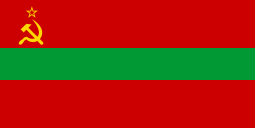 Moldavia- 25 February 1990
Moldavia- 25 February 1990 -
 Kirghizia – 25 February 1990
Kirghizia – 25 February 1990 -
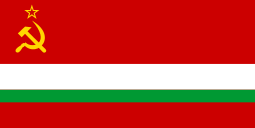 Tajikistan – 25 February 1990
Tajikistan – 25 February 1990 -
 Byelorussia – 3 March 1990
Byelorussia – 3 March 1990 -
 Russian SFSR – 4 March 1990
Russian SFSR – 4 March 1990 -
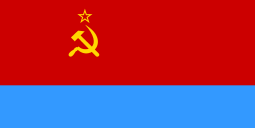 Ukraine – 4 March 1990
Ukraine – 4 March 1990 -
 East Germany – 18 March 1990
East Germany – 18 March 1990 -
 Estonia – 18 March 1990
Estonia – 18 March 1990 -
 Latvia – 18 March 1990
Latvia – 18 March 1990 -
 Hungary – 25 March 1990
Hungary – 25 March 1990 -
 Kazakhstan – 25 March 1990
Kazakhstan – 25 March 1990 -
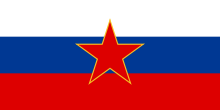 Slovenia – 8 April 1990
Slovenia – 8 April 1990 -
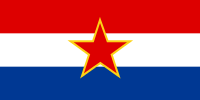 Croatia – 24 April 1990
Croatia – 24 April 1990 -
 Romania – 20 May 1990
Romania – 20 May 1990 -
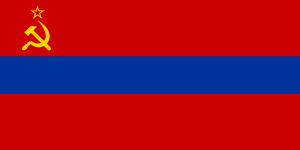 Armenia – 20 May 1990
Armenia – 20 May 1990 -
 Czechoslovakia – 8 June 1990
Czechoslovakia – 8 June 1990 -
.svg.png) Bulgaria – 10 June 1990
Bulgaria – 10 June 1990 -
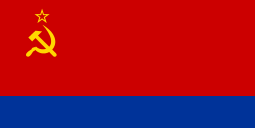 Azerbaijan – 30 September 1990
Azerbaijan – 30 September 1990 -
 Georgia – 28 October 1990
Georgia – 28 October 1990 -
 Macedonia – 11 November 1990
Macedonia – 11 November 1990 -
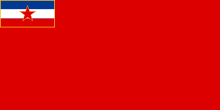 Bosnia and Herzegovina – 18 November 1990
Bosnia and Herzegovina – 18 November 1990 -
 Serbia – 8 December 1990
Serbia – 8 December 1990 -
 Montenegro – 9 December 1990
Montenegro – 9 December 1990 -
.svg.png) Albania – 7 April 1991
Albania – 7 April 1991
Dissolution of the Soviet Union
| Eastern Bloc |
|---|
 |
|
Allied states |
|
Dissent and opposition 1953 uprisings
1956 protests
|
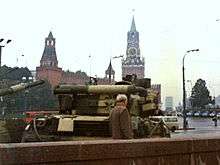
On 1 July 1991, the Warsaw Pact was officially dissolved at a meeting in Prague. At a summit later that same month, Gorbachev and Bush declared a US–Soviet strategic partnership, decisively marking the end of the Cold War. President Bush declared that US–Soviet cooperation during the 1990–91 Gulf War had laid the groundwork for a partnership in resolving bilateral and world problems.
As the Soviet Union rapidly withdrew its forces from Central and Southeast Europe, the spillover from the 1989 upheavals began reverberating throughout the Soviet Union itself. Agitation for self-determination led to first Lithuania, and then Estonia, Latvia and Armenia declaring independence. However, the Soviet central government demanded the revocation of the declarations and threatened military action and economic sanctions. The government even went as far as controversially sending Red Army troops to the streets of the Lithuanian capital, Vilnius, to suppress the separatist movements in January 1991, causing the deaths of 14 people.
Disaffection in other Soviet republics, such as Georgia and Azerbaijan, was countered by promises of greater decentralization. More open elections led to the election of candidates opposed to Communist Party rule.
Glasnost had inadvertently released the long-suppressed national sentiments of all peoples within the borders of the multinational Soviet state. These nationalist movements were further strengthened by the rapid deterioration of the Soviet economy, whose ramshackle foundations were exposed with the removal of Communist discipline. Gorbachev's reforms had failed to improve the economy, with the old Soviet command structure completely breaking down. One by one, the constituent republics created their own economic systems and voted to subordinate Soviet laws to local laws. In 1990, the Communist Party was forced to surrender its seven-decade monopoly of political power when the Supreme Soviet rescinded the clause in the Soviet Constitution that guaranteed its sole authority to rule. Gorbachev's policies caused the Communist Party to lose its grip over the media. Details of the Soviet Union's past were quickly being declassified. This caused many to distrust the 'old system' and push for greater autonomy and independence.
After a referendum confirmed the preservation of the Soviet Union but in a looser form, a group of Soviet hard-liners represented by Vice-President Gennadi Yanayev launched a coup attempting to overthrow Gorbachev in August 1991. Boris Yeltsin, then president of the Russian SFSR, rallied the people and much of the army against the coup and the effort collapsed. Although restored to power, Gorbachev's authority had been irreparably undermined. Gorbachev resigned as General Secretary of the Communist Party following the coup, and the Supreme Soviet dissolved the Party and banned all Communist activity on Soviet soil. Just a few weeks later, the government granted the Baltic states their independence on 6 September.
Over the next three months, one republic after another declared independence, mostly out of fear of another coup. Also during this time, the Soviet government was rendered useless as the new Russian government began taking over what remained of it, including the Kremlin. The penultimate step came on 1 December, when voters in the second most powerful republic, Ukraine, overwhelmingly voted to secede from the Soviet Union in a referendum. This ended any realistic chance of keeping the Soviet Union together. On 8 December, Yeltsin met with his counterparts from Ukraine and Belarus and signed the Belavezha Accords, declaring that the Soviet Union had ceased to exist. Gorbachev denounced this as illegal, but he had long since lost any ability to influence events outside of Moscow.
Two weeks later, 11 of the remaining 12 republics—all except Georgia—signed the Alma-Ata Protocol, which confirmed the Soviet Union had been effectively dissolved and replaced by a new voluntary association, the Commonwealth of Independent States. Bowing to the inevitable, Gorbachev resigned as Soviet president on 25 December, and the Supreme Soviet ratified the Belavezha Accords the next day, legally dissolving itself and the Soviet Union as a political entity. By the end of 1991, the few Soviet institutions that hadn't been taken over by Russia had dissolved. The Soviet Union was officially disbanded, breaking up into fifteen constituent parts, thereby ending the world's largest and most influential Socialist state, and leaving to China that position. A constitutional crisis dissolved into violence in Moscow as the Russian Army was called in to reestablish order.
Baltic States

Estonia, Latvia and Lithuania implemented democratic reforms and achieved independence from the Soviet Union.
The Singing Revolution is a commonly used name for events between 1987 and 1991 that led to the restoration of the independence of Estonia, Latvia and Lithuania.[57][58] The term was coined by an Estonian activist and artist, Heinz Valk, in an article published a week after the 10–11 June 1988 spontaneous mass night-singing demonstrations at the Tallinn Song Festival Grounds.[59] Estonia declared its sovereignty from the Soviet Union on 16 November 1988. Lithuania followed on 18 May 1989 and Latvia on 28 July 1989. Lithuania declared full independence on 11 March 1990 and on 30 March, Estonia announced the start of a transitional period to independence, followed by Latvia a few days later. These declarations were met with force from the Soviet Union in early 1991, in confrontations known as "The Barricades" in Latvia and the "January Events" in Lithuania. The Baltic states contended that their incorporation into the Soviet Union had been illegal under both international law and their own law, and they were reasserting an independence that still legally existed.
Soon after the launching of the August coup, Estonia and Latvia declared full independence. By the time the coup was foiled, the USSR was no longer unified enough to mount a forceful resistance, and it recognized the independence of the Baltic states on 6 September.
Belarus, Ukraine, Moldova
.svg.png) Belarus: A new postcommunist leader Alexander Lukashenko has obtained power. After a short period he increased his power as a result of referendum (1995–96) and has been criticized for repressing political opposition ever since.
Belarus: A new postcommunist leader Alexander Lukashenko has obtained power. After a short period he increased his power as a result of referendum (1995–96) and has been criticized for repressing political opposition ever since. Moldova – Participated in the War of Transnistria between Moldova and Russian-connected forces. Communists came back to power in a 2001 election under Vladimir Voronin, but faced civil unrest in 2009 over accusations of rigged elections.
Moldova – Participated in the War of Transnistria between Moldova and Russian-connected forces. Communists came back to power in a 2001 election under Vladimir Voronin, but faced civil unrest in 2009 over accusations of rigged elections. Ukraine – Ukraine declared its independence in August 1991. Presidencies of former Communists Leonid Kravchuk and Leonid Kuchma were followed by the Orange Revolution in 2004, in which Ukrainians elected Viktor Yushchenko (also former member of CPSU).
Ukraine – Ukraine declared its independence in August 1991. Presidencies of former Communists Leonid Kravchuk and Leonid Kuchma were followed by the Orange Revolution in 2004, in which Ukrainians elected Viktor Yushchenko (also former member of CPSU).
Transcaucasia

Georgia and the North Caucasus have been marred by ethnic and sectarian violence since the collapse of the USSR. In April 1989 the Soviet Army massacred demonstrators in Tbilisi. By November 1989, the Georgian SSR officially condemned the Russian invasion in 1921 and continuing genocidal occupation. Democracy activist Zviad Gamsakhurdia served as president from 1991 to 1992. Russia aided break-away republics in wars in South Ossetia and Abkhazia during the early 1990s, conflicts that have periodically reemerged, and Russia has accused Georgia of supporting Chechen rebels during the Chechen wars. A coup d'état installed former Communist leader Eduard Shevardnadze as President of Georgia until the Rose Revolution in 2003.
In Armenia, the independence struggle included violence. The Nagorno-Karabakh War was fought between Armenia and Azerbaijan. Armenia became increasingly militarized (with the ascendancy of Kocharian, a former president of Nagorno-Karabakh, often viewed as a milestone), while elections have since been increasingly controversial, and government corruption became more rife. After Kocharyan, notably, Serzh Sargsyan ascended to power. Sargsyan is often noted as the "founder of the Armenian and Karabakh militaries" and was, in the past, defense minister and national security minister.
In Azerbaijan the Azerbaijani Popular Front Party won first elections with the self-described pro-Western, populist nationalist Elchibey. However, Elchibey planned to end Moscow's advantage in the harvesting of Azeri oil and build much stronger links with Turkey and Europe, and as a result was overthrown by former Communists in a coup backed by Russia and Iran (which viewed the new country as a compelling threat, with territorial ambitions within Iranian borders and also being a strong economic rival).[60] Mutallibov rose to power, but he was soon destabilized and eventually ousted due to popular frustration with his perceived incompetence, corruption and improper handling of the war with Armenia. Azerbaijani KGB and Azerbaijani SSR leader Heydar Aliyev captured power and remained president until he transferred the presidency to his son in 2003. The Nagorno-Karabakh War was fought between Armenia and Azerbaijan, and has largely defined the fates of both countries. However, unlike Armenia, which remains a strong Russian ally, Azerbaijan has begun, since Russia's 2008 war with Georgia, to foster better relations with Turkey and other Western nations, while lessening ties with Russia.[61]
Chechnya
In Chechnya, using tactics partly copied from the Baltics, anti-Communist coalition forces led by former Soviet general Dzhokhar Dudayev staged a largely bloodless revolution, and ended up forcing the resignation of the Communist republican president. Dudayev was elected in a landslide in the following election and in November 1991 he proclaimed Checheno-Ingushetia's independence as the Republic of Ichkeria. Ingushetia voted to leave the union with Chechnya, and was allowed to do so (thus it became the Chechen Republic of Ichkeria). Due to his desire to exclude Moscow from all oil deals, Yeltsin backed a failed coup against him in 1993. In 1994, Chechnya, with only marginal recognition (one country: Georgia, which was revoked soon after the coup landing Shevardnadze in power), was invaded by Russia, spurring the First Chechen War. The Chechens, with considerable assistance from the populations of both former-Soviet countries and from Sunni Muslim countries repelled this invasion and a peace treaty was signed in 1997. However, Chechnya became increasingly anarchic, largely due to the both political and physical destruction of the state during the invasion, and general Shamil Basaev, having evaded all control by the central government, conducted raids into neighboring Dagestan, which Russia used as pretext for reinvading Ichkeria. Ichkeria was then reincorporated into Russia as Chechnya again, though fighting continues.
Central Asia
-
 Kazakhstan: The independence struggle began with the Jeltoqsan uprising in 1986. Former Communist leader Nursultan Nazarbayev has been in power since 1990 when he started serving as President of Kazakh SSR.
Kazakhstan: The independence struggle began with the Jeltoqsan uprising in 1986. Former Communist leader Nursultan Nazarbayev has been in power since 1990 when he started serving as President of Kazakh SSR. -
.svg.png) Kyrgyzstan: Askar Akayev retained power until the Tulip Revolution in 2005.
Kyrgyzstan: Askar Akayev retained power until the Tulip Revolution in 2005. -
.svg.png) Tajikistan: Rahmon Nabiyev retained power, which led to the civil war in Tajikistan. Emomalii Rahmon has succeeded Nabiyev and has retained power since 1992.
Tajikistan: Rahmon Nabiyev retained power, which led to the civil war in Tajikistan. Emomalii Rahmon has succeeded Nabiyev and has retained power since 1992. -
 Turkmenistan: Saparmurat Niyazov retained power until his death in 2006 and was criticized as one of the world's most totalitarian and repressive leaders, maintaining his own cult of personality.
Turkmenistan: Saparmurat Niyazov retained power until his death in 2006 and was criticized as one of the world's most totalitarian and repressive leaders, maintaining his own cult of personality. -
 Uzbekistan: Islam Karimov retained power until his death in 2016, and was widely criticized for repressing the political opposition throughout his tenure.
Uzbekistan: Islam Karimov retained power until his death in 2016, and was widely criticized for repressing the political opposition throughout his tenure.
Post-Soviet conflicts
Russia was involved in a number of conflicts, including the Nagorno-Karabakh War, the War of Transnistria, the 1991–1992 South Ossetia War, the First Chechen War, the War in Abkhazia, the Ossetian–Ingush conflict, and the Crimea conflict in Ukraine.
Other events
Communist and Socialist countries
Reforms in the Soviet Union and its allied countries also saw dramatic changes to Communist and Socialist states outside of Europe.
Africa
-
 Algeria – 1988 October Riots, Islamist insurgency in Algeria 1991–2002 and FLN lost the multi-party elections in 1995, and Liamine Zéroual won.
Algeria – 1988 October Riots, Islamist insurgency in Algeria 1991–2002 and FLN lost the multi-party elections in 1995, and Liamine Zéroual won. -
 Angola – The ruling MPLA government abandoned Marxism-Leninism in 1991 and agreed to the Bicesse Accords in the same year, however the Angolan Civil War between the MPLA and the conservative UNITA continued for another decade.
Angola – The ruling MPLA government abandoned Marxism-Leninism in 1991 and agreed to the Bicesse Accords in the same year, however the Angolan Civil War between the MPLA and the conservative UNITA continued for another decade. -
.svg.png) Benin – Mathieu Kérékou's regime was pressured to abandon Marxism-Leninism in 1989.
Benin – Mathieu Kérékou's regime was pressured to abandon Marxism-Leninism in 1989. -
 Burkina Faso – democratization in 1990.
Burkina Faso – democratization in 1990. -
.svg.png) Cape Verde – The ruling African Party for the Independence of Cape Verde party cut down its Socialist ideology and foreign donors pressured the government to allow multiparty elections in 1991.
Cape Verde – The ruling African Party for the Independence of Cape Verde party cut down its Socialist ideology and foreign donors pressured the government to allow multiparty elections in 1991. -
 Chad – democratization in 1990.
Chad – democratization in 1990. -
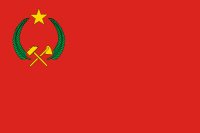 Congo-Brazzaville – Denis Sassou Nguesso's regime was pressured to abandon Marxism-Leninism in 1991. The nation had elections in 1992 and First Republic of the Congo Civil War in 1993.
Congo-Brazzaville – Denis Sassou Nguesso's regime was pressured to abandon Marxism-Leninism in 1991. The nation had elections in 1992 and First Republic of the Congo Civil War in 1993. -
 Djibouti – Djiboutian Civil War in 1991 and democratization in 1992.
Djibouti – Djiboutian Civil War in 1991 and democratization in 1992. -
.svg.png) Ethiopia – A new constitution was implemented in 1987 and, following the withdrawal of Soviet and Cuban assistance, the Communist military junta Derg led by Mengistu Haile Mariam was defeated by the rebel EPRDF in the Ethiopian Civil War and fled in 1991.
Ethiopia – A new constitution was implemented in 1987 and, following the withdrawal of Soviet and Cuban assistance, the Communist military junta Derg led by Mengistu Haile Mariam was defeated by the rebel EPRDF in the Ethiopian Civil War and fled in 1991. -
 Guinea-Bissau – democratization in 1991.
Guinea-Bissau – democratization in 1991. -
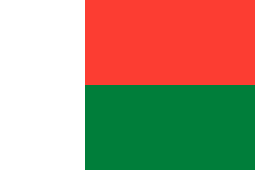 Madagascar – Socialist President Didier Ratsiraka was ousted.
Madagascar – Socialist President Didier Ratsiraka was ousted. -
 Mali – Moussa Traoré was ousted, Mali adopted a new constitution; held multi-party elections. Rebellion in 1990 and coup d'état in 1991.
Mali – Moussa Traoré was ousted, Mali adopted a new constitution; held multi-party elections. Rebellion in 1990 and coup d'état in 1991. -
 Mozambique – The Mozambican Civil War between the socialist FRELIMO and the RENAMO conservatives was ended via treaty in 1992. FRELIMO subsequently abandoned socialism and with the support of the UN, held multiparty elections.
Mozambique – The Mozambican Civil War between the socialist FRELIMO and the RENAMO conservatives was ended via treaty in 1992. FRELIMO subsequently abandoned socialism and with the support of the UN, held multiparty elections. -
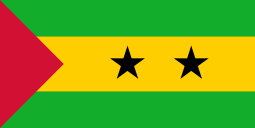 São Tomé and Príncipe – The ruling Movement for the Liberation of São Tomé and Príncipe/Social Democratic Party cut down its Socialist ideology and foreign donors pressured the government to allow multiparty elections in 1991.
São Tomé and Príncipe – The ruling Movement for the Liberation of São Tomé and Príncipe/Social Democratic Party cut down its Socialist ideology and foreign donors pressured the government to allow multiparty elections in 1991. -
.svg.png) Seychelles – democratization in 1991.
Seychelles – democratization in 1991. -
 Somalia – Rebelling Somalis overthrew Siad Barre's Communist military junta during the Somali Revolution. Somalia has been in a constant state of civil war ever since.
Somalia – Rebelling Somalis overthrew Siad Barre's Communist military junta during the Somali Revolution. Somalia has been in a constant state of civil war ever since. -
 Sudan – End the reign of the Democratic Unionist Party by coup d'état Omar al-Bashir in 1989
Sudan – End the reign of the Democratic Unionist Party by coup d'état Omar al-Bashir in 1989 -
 Tanzania – The ruling Chama Cha Mapinduzi party cut down its Socialist ideology and foreign donors pressured the government to allow multiparty elections in 1995.
Tanzania – The ruling Chama Cha Mapinduzi party cut down its Socialist ideology and foreign donors pressured the government to allow multiparty elections in 1995. -
 Tunisia – Renaming the Tunisian Communist Party in Ettajdid Movement in 1993 and renaming the Socialist Destourian Party in Democratic Constitutional Rally in 1988.
Tunisia – Renaming the Tunisian Communist Party in Ettajdid Movement in 1993 and renaming the Socialist Destourian Party in Democratic Constitutional Rally in 1988. -
.svg.png) Zambia – The ruling United National Independence Party cut down its Socialist ideology and foreign donors pressured the government to allow multiparty elections in 1991.
Zambia – The ruling United National Independence Party cut down its Socialist ideology and foreign donors pressured the government to allow multiparty elections in 1991.
Middle East
-
.svg.png) Afghanistan – Renamed Republic of Afghanistan in 1987, Soviet occupation ended and the Communist government under Mohammad Najibullah fell to the Mujahideen in 1992.
Afghanistan – Renamed Republic of Afghanistan in 1987, Soviet occupation ended and the Communist government under Mohammad Najibullah fell to the Mujahideen in 1992. -
%3B_Flag_of_Syria_(1963-1972).svg.png) Iraq – uprisings in 1991.
Iraq – uprisings in 1991. -
 Kuwait – Annexed by Iraq in 1990.
Kuwait – Annexed by Iraq in 1990. -
 Palestinian Territories – The Palestine Liberation Organization lost one of its most important diplomatic patrons, due to the deterioration of the Soviet Union, Arafat's failing relationship with Moscow and loss of a one-party government and Suspension PFLP-GC of the PLO in 1984.
Palestinian Territories – The Palestine Liberation Organization lost one of its most important diplomatic patrons, due to the deterioration of the Soviet Union, Arafat's failing relationship with Moscow and loss of a one-party government and Suspension PFLP-GC of the PLO in 1984. -
 South Yemen – South Yemen Civil War in 1986; Abandoned Marxism-Leninism in 1990; it reunified with the more capitalist North Yemen that year, though this later led to a civil war.
South Yemen – South Yemen Civil War in 1986; Abandoned Marxism-Leninism in 1990; it reunified with the more capitalist North Yemen that year, though this later led to a civil war. -
 Syria – The Syrian Communist Party was divided to two parties in 1986. Syria participated in the Madrid Conference of 1991 and met its Cold War enemy Israel in peace negotiations. The Syrian Democratic People's Party from the Left-wing to center-left.
Syria – The Syrian Communist Party was divided to two parties in 1986. Syria participated in the Madrid Conference of 1991 and met its Cold War enemy Israel in peace negotiations. The Syrian Democratic People's Party from the Left-wing to center-left.
Asia

-
 Bangladesh – Internal conflict from 1989.
Bangladesh – Internal conflict from 1989. -
.svg.png) Burma – The 8888 Uprising in 1988 saw the demise of the Burma Socialist Programme Party, but failed to bring democracy, although Marxism was abandoned. The country was led by a military government under the State Peace and Development Council until 2011, following 2010 elections viewed by many Western countries as fraudulent. End of the Communist insurgency in 1989.
Burma – The 8888 Uprising in 1988 saw the demise of the Burma Socialist Programme Party, but failed to bring democracy, although Marxism was abandoned. The country was led by a military government under the State Peace and Development Council until 2011, following 2010 elections viewed by many Western countries as fraudulent. End of the Communist insurgency in 1989. -
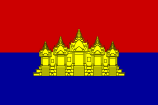 Cambodia – The Vietnam-supported government, which had been in power since the fall of the Khmer Rouge, lost power following UN-sponsored elections in 1993, the CGDK was dissolved in 1993 and the Party of Democratic Kampuchea was dissolved in 1992.
Cambodia – The Vietnam-supported government, which had been in power since the fall of the Khmer Rouge, lost power following UN-sponsored elections in 1993, the CGDK was dissolved in 1993 and the Party of Democratic Kampuchea was dissolved in 1992. -
 People's Republic of China – The Communist Party of China began implementing liberalizing economic reforms during the late 1970s under Deng Xiaoping. However, the pro-democracy protests of 1989 were crushed by the military. Unrest in Tibet in 1987. The URFET and the ETPRP was dissolved.
People's Republic of China – The Communist Party of China began implementing liberalizing economic reforms during the late 1970s under Deng Xiaoping. However, the pro-democracy protests of 1989 were crushed by the military. Unrest in Tibet in 1987. The URFET and the ETPRP was dissolved. -
 India – Indian economic reforms were launched in 1991. And Resolution of the People's Party of Arunachal. The Rashtriya Samajwadi Congress was dissolved in 1989, Tripura National Volunteers was dissolved in 1988 and Hmar People's Convention was dissolved in 1986. Begin of the Insurgency in Jammu and Kashmir in 1989.
India – Indian economic reforms were launched in 1991. And Resolution of the People's Party of Arunachal. The Rashtriya Samajwadi Congress was dissolved in 1989, Tripura National Volunteers was dissolved in 1988 and Hmar People's Convention was dissolved in 1986. Begin of the Insurgency in Jammu and Kashmir in 1989. -
 Laos – Remained Communist under the Lao People's Revolutionary Party. Laos was forced to ask France and Japan for emergency assistance, and also to ask the World Bank and the Asian Development Bank for aid. Finally, in 1989, Kaisôn visited Beijing to confirm the restoration of friendly relations, and to secure Chinese aid. The red star and the hammer and sickle was taken out from the crest in 1991.
Laos – Remained Communist under the Lao People's Revolutionary Party. Laos was forced to ask France and Japan for emergency assistance, and also to ask the World Bank and the Asian Development Bank for aid. Finally, in 1989, Kaisôn visited Beijing to confirm the restoration of friendly relations, and to secure Chinese aid. The red star and the hammer and sickle was taken out from the crest in 1991. -
.svg.png) Mongolia – The 1990 Democratic Revolution in Mongolia saw a gradual moved to allow free multi-party elections and the writing of the new constitution. The Mongolian People's Revolutionary Party retained its majority in the 1990 elections, but lost the 1996 elections.
Mongolia – The 1990 Democratic Revolution in Mongolia saw a gradual moved to allow free multi-party elections and the writing of the new constitution. The Mongolian People's Revolutionary Party retained its majority in the 1990 elections, but lost the 1996 elections. -
 North Korea – Kim Il-sung died in 1994, passing power to his son Kim Jong-il. Unprecedented floods and the dissolution of the Soviet Union led to the North Korean famine, which resulted in the deaths of an estimated 2.5 million to 3 million North Koreans. All references to Marxism-Leninism were replaced by Juche in 1992, thus signifying an apparent downplaying of the role of Communism in North Korea.
North Korea – Kim Il-sung died in 1994, passing power to his son Kim Jong-il. Unprecedented floods and the dissolution of the Soviet Union led to the North Korean famine, which resulted in the deaths of an estimated 2.5 million to 3 million North Koreans. All references to Marxism-Leninism were replaced by Juche in 1992, thus signifying an apparent downplaying of the role of Communism in North Korea. -
 Sri Lanka – 1989 Revolt
Sri Lanka – 1989 Revolt -
 Vietnam – The Communist Party of Vietnam has undertaken Doi Moi reforms since 1986, liberalizing certain sectors of the economy in a manner similar to China. Vietnam is still a single-party Communist state.
Vietnam – The Communist Party of Vietnam has undertaken Doi Moi reforms since 1986, liberalizing certain sectors of the economy in a manner similar to China. Vietnam is still a single-party Communist state.
Latin America
-
 Cuba – The end of Soviet subsidies led to the Special Period. Introduction of non-selectable parties in 1992. An unsuccessful protest was held in 1994.
Cuba – The end of Soviet subsidies led to the Special Period. Introduction of non-selectable parties in 1992. An unsuccessful protest was held in 1994. -
 Nicaragua – Daniel Ortega's Sandinista lost the multi-party elections in 1990, and the National Opposition Union won.
Nicaragua – Daniel Ortega's Sandinista lost the multi-party elections in 1990, and the National Opposition Union won. -
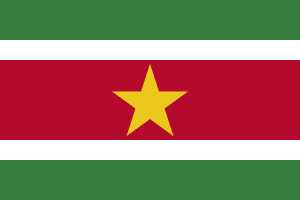 Suriname – democratization in 1987 and Suriname Guerrilla War 1986–1992.
Suriname – democratization in 1987 and Suriname Guerrilla War 1986–1992.
Oceania
-
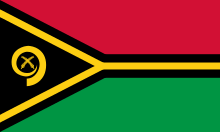 Vanuatu – Vanua'aku Pati lost the multi-party elections in 1991, and the Union of Moderate Parties won.
Vanuatu – Vanua'aku Pati lost the multi-party elections in 1991, and the Union of Moderate Parties won.
Other countries
Many Soviet-supported political parties and militant groups around the world suffered from demoralization and loss of financing.
-
 Australia – The Communist Party of Australia was dissolved.
Australia – The Communist Party of Australia was dissolved. -
 Austria – The Communist Party of Austria lost its East Deutsch financing and 250 million euros in assets.
Austria – The Communist Party of Austria lost its East Deutsch financing and 250 million euros in assets. -
.svg.png) Belgium – The Communist Party of Belgium was divided to two parties in 1989.
Belgium – The Communist Party of Belgium was divided to two parties in 1989. -
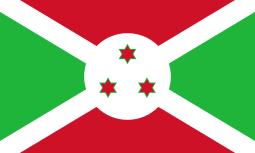 Burundi – 1996 Burundian coup d'état
Burundi – 1996 Burundian coup d'état -
 Canada - In 1990 the party was de-registered and had its assets seized, forcing it to begin an ultimately successful thirteen-year political and legal battle to maintain registration of small political parties in Canada known as Figueroa v. Canada, thus changing the legal definition of a political party in Canada in 2003 and now operates without any elected political representation.
Canada - In 1990 the party was de-registered and had its assets seized, forcing it to begin an ultimately successful thirteen-year political and legal battle to maintain registration of small political parties in Canada known as Figueroa v. Canada, thus changing the legal definition of a political party in Canada in 2003 and now operates without any elected political representation. -
 Finland – The Finnish People's Democratic League was dissolved in 1990 and the bankrupt Communist Party of Finland collapsed in 1992, and absorbed to the Left Alliance.
Finland – The Finnish People's Democratic League was dissolved in 1990 and the bankrupt Communist Party of Finland collapsed in 1992, and absorbed to the Left Alliance. -
 France – The collapse of the Eastern Bloc came as a shock to the French Communist Party. The crisis is called la mutation. Fusion of the Unified Socialist Party with the New Left for Socialism, Ecology and Self-management for Red and Green Alternatives in 1989.
France – The collapse of the Eastern Bloc came as a shock to the French Communist Party. The crisis is called la mutation. Fusion of the Unified Socialist Party with the New Left for Socialism, Ecology and Self-management for Red and Green Alternatives in 1989. -
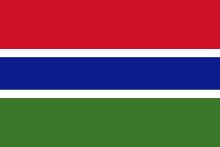 Gambia – 1994 Gambian coup d'état
Gambia – 1994 Gambian coup d'état -
 West Germany – The Red Army Faction lost its long-term supporter, the Stasi, after the Berlin Wall fell.[62]
West Germany – The Red Army Faction lost its long-term supporter, the Stasi, after the Berlin Wall fell.[62] -
 Greece – The Organisation of Marxist-Leninist Communists of Greece was dissolved in 1993 and merged into the Movement for a United Communist Party of Greece. Greek Left was dissolved in 1992.
Greece – The Organisation of Marxist-Leninist Communists of Greece was dissolved in 1993 and merged into the Movement for a United Communist Party of Greece. Greek Left was dissolved in 1992. -
 Ireland – The Communist Party of Ireland declined significantly. Democratic Socialist Party was dissolved.
Ireland – The Communist Party of Ireland declined significantly. Democratic Socialist Party was dissolved. -
 Italy – The collapse caused the Italian Communist Party to reform itself, creating two new groups, the larger Democratic Party of the Left and the smaller Communist Refoundation Party. The disappearance of the Communist party in part led to profound changes within the Italian political party system in 1992–1994 and Collapse of the Radical Party in 1989 and the Italian Socialist Party in 1994. Disintegration of the Red Brigades in 1988.
Italy – The collapse caused the Italian Communist Party to reform itself, creating two new groups, the larger Democratic Party of the Left and the smaller Communist Refoundation Party. The disappearance of the Communist party in part led to profound changes within the Italian political party system in 1992–1994 and Collapse of the Radical Party in 1989 and the Italian Socialist Party in 1994. Disintegration of the Red Brigades in 1988. -
 Japan – The Japanese Communist Party issued a statement titled "We welcome the end of a great historical evil of imperialism and hegemonism".
Japan – The Japanese Communist Party issued a statement titled "We welcome the end of a great historical evil of imperialism and hegemonism". -
 Lebanon – End of the Civil War
Lebanon – End of the Civil War -
 Liberia – First Liberian Civil War
Liberia – First Liberian Civil War -
 Malaysia – The Malayan Communist Party laid down its arms in 1989, ending an insurgency that had lasted decades.
Malaysia – The Malayan Communist Party laid down its arms in 1989, ending an insurgency that had lasted decades. -
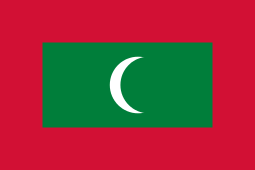 Maldives – the failed 1988 Maldives coup d'état
Maldives – the failed 1988 Maldives coup d'état -
 Mexico – The Mexican Communist Party and a number of other Communist parties were dissolved in 1989 and absorbed first into the Mexican Socialist Party and then into the Party of the Democratic Revolution. And collapse of the Socialist Mexican Party in 1989.
Mexico – The Mexican Communist Party and a number of other Communist parties were dissolved in 1989 and absorbed first into the Mexican Socialist Party and then into the Party of the Democratic Revolution. And collapse of the Socialist Mexican Party in 1989. -
 Morocco – End of the Western Sahara War in 1991.
Morocco – End of the Western Sahara War in 1991. -
 Nepal – The Communist Party of Nepal (Janamukhi) and the Communist Party of Nepal (Fourth Convention) was dissolved in 1990.
Nepal – The Communist Party of Nepal (Janamukhi) and the Communist Party of Nepal (Fourth Convention) was dissolved in 1990. -
 Netherlands – The Communist Party of the Netherlands was dissolved in 1991 and absorbed to the GreenLeft. League of Communists in the Netherlands was dissolved in 1992.
Netherlands – The Communist Party of the Netherlands was dissolved in 1991 and absorbed to the GreenLeft. League of Communists in the Netherlands was dissolved in 1992. -
 Niger – Coup d'état in 1996.
Niger – Coup d'état in 1996. -
 Norway – The Communist Party of Norway changed their pro-Soviet line.
Norway – The Communist Party of Norway changed their pro-Soviet line. -
 Oman – The Popular Front for the Liberation of Oman was dissolved in 1992.
Oman – The Popular Front for the Liberation of Oman was dissolved in 1992. -
 Peru – The Shining Path, responsible for killing tens of thousands people, shrunk in the 1990s.
Peru – The Shining Path, responsible for killing tens of thousands people, shrunk in the 1990s. -
.svg.png) Philippines – The Communist Party of the Philippines experienced criticism and the debates that ensued between the leading party cadres resulted to the expulsion of advocates of "left and right opportunism" notably forming the so-called "rejectionists" and "reaffirmist" factions. Those who affirmed the Maoist orthodoxy were called the "Reaffirmists", or RA, while those who rejected the document were called "Rejectionists" or RJ. In July 1993, the Komiteng Rehiyon ng Manila-Rizal (KRMR), one of the Rejectionists, declared its autonomy from the central leadership. Within a few months, several of the Party's regional formations and bureaus followed suit, permanently formalizing and deepening the schism. See a comprehensive third-party account of the schism here: <http://pcij.org/imag/SpecialReport/left.html>
Philippines – The Communist Party of the Philippines experienced criticism and the debates that ensued between the leading party cadres resulted to the expulsion of advocates of "left and right opportunism" notably forming the so-called "rejectionists" and "reaffirmist" factions. Those who affirmed the Maoist orthodoxy were called the "Reaffirmists", or RA, while those who rejected the document were called "Rejectionists" or RJ. In July 1993, the Komiteng Rehiyon ng Manila-Rizal (KRMR), one of the Rejectionists, declared its autonomy from the central leadership. Within a few months, several of the Party's regional formations and bureaus followed suit, permanently formalizing and deepening the schism. See a comprehensive third-party account of the schism here: <http://pcij.org/imag/SpecialReport/left.html> -
 San Marino – The Sammarinese Communist Party was dissolved in 1990.
San Marino – The Sammarinese Communist Party was dissolved in 1990. -
 Sierra Leone – The beginning of the Sierra Leone Civil War in 1990 and coup d'état in 1992.
Sierra Leone – The beginning of the Sierra Leone Civil War in 1990 and coup d'état in 1992. -
 Singapore – The Barisan Sosialis was dissolved in 1988.
Singapore – The Barisan Sosialis was dissolved in 1988. -
 Spain – The Workers' Party of Spain–Communist Unity was dissolved in 1991. Alternative Left was dissolved in 1993. Communist Party of Spain (Marxist–Leninist) (historical) was dissolved in 1992. The Communist Party of Galicia (Revolutionary Marxist) was dissolved in 1989.
Spain – The Workers' Party of Spain–Communist Unity was dissolved in 1991. Alternative Left was dissolved in 1993. Communist Party of Spain (Marxist–Leninist) (historical) was dissolved in 1992. The Communist Party of Galicia (Revolutionary Marxist) was dissolved in 1989. -
 Sweden – The Communist Association of Norrköping was dissolved in 1990 and Kommunistiska Förbundet Marxist-Leninisterna ceased to function as nationwide party. The pro-Albanian Kommunistiska Partiet i Sverige and the Maoist Communist Workers' Party of Sweden were dissolved in 1993. The main leftist party, Vänsterpartiet kommunisterna, VPK (Left Party – Communists), abandoned the Communist part of its name, and became simply Vänsterpartiet (Left Party).
Sweden – The Communist Association of Norrköping was dissolved in 1990 and Kommunistiska Förbundet Marxist-Leninisterna ceased to function as nationwide party. The pro-Albanian Kommunistiska Partiet i Sverige and the Maoist Communist Workers' Party of Sweden were dissolved in 1993. The main leftist party, Vänsterpartiet kommunisterna, VPK (Left Party – Communists), abandoned the Communist part of its name, and became simply Vänsterpartiet (Left Party). -
 Turkey – The Communist Labour Party of Turkey was split.
Turkey – The Communist Labour Party of Turkey was split. -
 United Kingdom – The Communist Party of Great Britain was dissolved.
United Kingdom – The Communist Party of Great Britain was dissolved.
Concurrently, many anti-Communist authoritarian states, formerly supported by the US, gradually saw a transition to democracy.
-
 Brazil had the first democratic presidential election since 1960 due to reforms started a few years earlier.
Brazil had the first democratic presidential election since 1960 due to reforms started a few years earlier. -
 Chile – The military junta under Augusto Pinochet was pressured to implement democratic elections, which saw Chile's democratization in 1990. The Broad Party of Socialist Left Merged into Socialist Party of Chile.
Chile – The military junta under Augusto Pinochet was pressured to implement democratic elections, which saw Chile's democratization in 1990. The Broad Party of Socialist Left Merged into Socialist Party of Chile. -
 Republic of China – The nationalist Kuomintang party that had ruled under strict martial law since the end of the Chinese Civil War introduced democratizing reforms.
Republic of China – The nationalist Kuomintang party that had ruled under strict martial law since the end of the Chinese Civil War introduced democratizing reforms. -
 Colombia – The conservative constitution of 1886 was repealed in 1991. The 19th of April Movement, the Quintin Lame Armed Movement and mostly of the Popular Liberation Army gave up their weapons and began to participate in politics.
Colombia – The conservative constitution of 1886 was repealed in 1991. The 19th of April Movement, the Quintin Lame Armed Movement and mostly of the Popular Liberation Army gave up their weapons and began to participate in politics. -
 El Salvador – The Salvadoran Civil War ended in 1992 following the Chapultepec Peace Accords. The rebel FMLN movement became a legal political party and participated in subsequent elections.
El Salvador – The Salvadoran Civil War ended in 1992 following the Chapultepec Peace Accords. The rebel FMLN movement became a legal political party and participated in subsequent elections. -
 Guatemala – The Guatemalan Civil War ended in 1996 and the rebel Guatemalan National Revolutionary Unity became a legal party.
Guatemala – The Guatemalan Civil War ended in 1996 and the rebel Guatemalan National Revolutionary Unity became a legal party. -
 Panama – The Manuel Noriega regime was overthrown by the US invasion in 1989 as a result of his suppression of elections, drug-trafficking activities and the killing of a US serviceman.
Panama – The Manuel Noriega regime was overthrown by the US invasion in 1989 as a result of his suppression of elections, drug-trafficking activities and the killing of a US serviceman. -
.svg.png) Paraguay – The dictatorship of Alfredo Stroessner came to an end when he was deposed in a military coup d'état. In 1992, the country's new constitution established a democratic system of government.
Paraguay – The dictatorship of Alfredo Stroessner came to an end when he was deposed in a military coup d'état. In 1992, the country's new constitution established a democratic system of government. -
.svg.png) Philippines – Yellow Revolution in 1986.
Philippines – Yellow Revolution in 1986. -
.svg.png) Rwanda – Rwandan Civil War in 1990.
Rwanda – Rwandan Civil War in 1990. -
 South Korea – The June Democracy Movement's protests led to the fall of the Chun Doo-hwan government in 1987, and the country's first democratic elections. In 2000, North and South Korea agreed in principle to work towards peaceful reunification in the future.
South Korea – The June Democracy Movement's protests led to the fall of the Chun Doo-hwan government in 1987, and the country's first democratic elections. In 2000, North and South Korea agreed in principle to work towards peaceful reunification in the future. -
.svg.png) South Africa – Negotiations were started in 1990 to end the Apartheid system. Nelson Mandela was elected as the President of South Africa in 1994.
South Africa – Negotiations were started in 1990 to end the Apartheid system. Nelson Mandela was elected as the President of South Africa in 1994. -
 United States – Following the end of the Cold War, the United States became the world's sole superpower. It ceased to support many of the military dictatorships it had during the Cold War, pressing more nations to adopt democracy.
United States – Following the end of the Cold War, the United States became the world's sole superpower. It ceased to support many of the military dictatorships it had during the Cold War, pressing more nations to adopt democracy. -
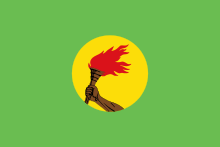 Zaire – Civil War in 1996.
Zaire – Civil War in 1996.
Political reforms
Decommunization is a process of overcoming the legacies of the Communist state establishments, culture, and psychology in the post-Communist states.
Decommunization was largely limited or non-existent. Communist parties were not outlawed and their members were not brought to trial. Just a few places even attempted to exclude members of communist secret services from decision-making. In a number of countries the Communist party simply changed its name and continued to function.[63]
In several European countries, however, endorsing or attempting to justify crimes committed by Nazi or Communist regimes will be punishable by up to 3 years of imprisonment.[64]
Economic reforms
State run enterprises in socialist countries had little or no interest in producing what customers wanted which resulted in shortages of goods and services.[65] In the early 1990s, the general view was that there was no precedent for moving from socialism to capitalism",[66] and only some elderly people remembered how a market economy worked. As result the view that Central, Southeastern and Eastern Europe would stay poor for decades was common.[67]
There was a temporary fall of output in the official economy and an increase in black market economic activity.[65] Countries implemented different reform programs. One example, generally regarded as successful was the "shock therapy" Balcerowicz Plan in Poland. Eventually the official economy began to grow.[65]
In a 2007 paper Oleh Havrylyshyn categorized the speed of reforms in the Soviet Bloc:[66]
- Sustained Big-Bang (fastest): Estonia, Latvia, Lithuania, Czech Republic, Poland, Slovakia
- Advance Start/Steady Progress: Croatia, Hungary, Slovenia
- Aborted Big-Bang: Albania, Bulgaria, Macedonia, Kyrgyzstan, Russia
- Gradual Reforms: Azerbaijan, Armenia, Georgia, Kazakhstan, Ukraine, Tajikistan, Romania
- Limited Reforms (slowest): Belarus, Uzbekistan, Turkmenistan
The 2004 enlargement of the European Union included the Czech Republic, Estonia, Hungary, Latvia, Lithuania, Poland, Slovakia, and Slovenia. The 2007 enlargement of the European Union included Romania and Bulgaria, and Croatia joined the EU in 2013. The same countries have also become NATO members.
Chinese economic liberalization started since 1978 have helped lift millions of people out of poverty, bringing the poverty rate down from 53% of the population in the Mao era to 12% in 1981. Deng's economic reforms are still being followed by the CPC today and by 2001 the poverty rate became only 6% of the population.[68]
Economic liberalization in Vietnam was initiated in 1986, following the Chinese example.
Economic liberalization in India was initiated in 1991.
Harvard University Professor Richard B. Freeman has called the effect of reforms "The Great Doubling". He calculated that the size of the global workforce doubled from 1.46 billion workers to 2.93 billion workers.[69][70] An immediate effect was a reduced ratio of capital to labor. In the long, term China, India, and the former Soviet bloc will save and invest and contribute to the expansion of the world capital stock.[70]
Ideological continuation of communism
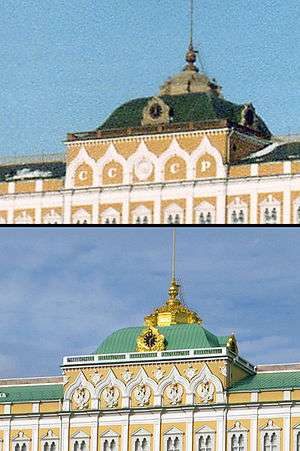
Compared with the efforts of the other former constituents of the Soviet bloc and the Soviet Union, decommunization in Russia has been restricted to half-measures, if conducted at all.[71] As of 2008, nearly half of Russians viewed Stalin positively, and many supported restoration of his previously dismantled monuments.[72][73] Neo-Stalinist material such as describing Stalin's mass murder campaigns as "entirely rational" has been pushed into Russian textbooks.[74]
In 1992, President Yeltsin's government invited Vladimir Bukovsky to serve as an expert to testify at the CPSU trial by Constitutional Court of Russia, where the Communists were suing Yeltsin for banning their party. The respondent's case was that the CPSU itself had been an unconstitutional organization. To prepare for his testimony, Bukovsky requested and was granted access to a large number of documents from Soviet archives (then reorganized into TsKhSD). Using a small handheld scanner and a laptop computer, he managed to secretly scan many documents (some with high security clearance), including KGB reports to the Central Committee, and smuggle the files to the West.[75] The event that many expected would be another Nuremberg Trial and the beginnings of reconciliation with the Communist past, ended up in half-measures: while the CPSU was found unconstitutional, the Communists were allowed to form new parties in the future. Bukovsky expressed his deep disappointment with this in his writings and interviews: “Having failed to finish off conclusively the Communist system, we are now in danger of integrating the resulting monster into our world. It may not be called Communism anymore, but it retained many of its dangerous characteristics... Until the Nuremberg-style tribunal passes its judgment on all the crimes committed by Communism, it is not dead and the war is not over.”[76]
Interpretations
The events caught many by surprise. Predictions of the Soviet Union's impending demise had been often dismissed.[77]
Bartlomiej Kaminski's book The Collapse of State Socialism argued that the state Socialist system has a lethal paradox: "policy actions designed to improve performance only accelerate its decay".[78]
By the end of 1989, revolts had spread from one capital to another, ousting the regimes imposed on Central, South-East and Eastern Europe after World War II. Even the isolationist Stalinist regime in Albania was unable to stem the tide. Gorbachev's abrogation of the Brezhnev Doctrine was perhaps the key factor that enabled the popular uprisings to succeed. Once it became evident that the feared Soviet Army would not intervene to crush dissent, the Central, South-East and Eastern European regimes were exposed as vulnerable in the face of popular uprisings against the one-party system and power of secret police.
Coit D. Blacker wrote in 1990 that the Soviet leadership "appeared to have believed that whatever loss of authority the Soviet Union might suffer in Central and South-East Europe would be more than offset by a net increase in its influence in western Europe."[79] Nevertheless, it is unlikely that Gorbachev ever intended for the complete dismantling of Communism and the Warsaw Pact. Rather, Gorbachev assumed that the Communist parties of Central and South-East Europe could be reformed in a similar way to the reforms he hoped to achieve in the CPSU. Just as perestroika was aimed at making the Soviet Union more efficient economically and politically, Gorbachev believed that the Comecon and Warsaw Pact could be reformed into more effective entities. However, Alexander Yakovlev, a close advisor to Gorbachev, would later state that it would have been "absurd to keep the system" in Central and South-East Europe. Yakovlev had come to the conclusion that the Soviet-dominated Comecon could not work on non-market principles and that the Warsaw Pact had "no relevance to real life."[18]
Remembrance
Organizations
- Memorial – Memorial is an international historical and civil rights society that operates in a number of post-Soviet states. It focuses on recording and publicising the Soviet Union's totalitarian aspect of the past, but also monitors human rights in post-Soviet states at the present time, for example in Chechnya.[80]
Events
- German Unity Day in Germany – A national holiday commemorating the anniversary of German reunification in 1990
- Statehood Day in Slovenia – Commemorates the country's declaration of independence from Yugoslavia in 1991.
- Independence and Unity Day in Slovenia – Commemorates the country's independence referendum.
- Day of National Unity in Georgia – is a public holiday commemorating victims of the 9 April tragedy
- National Day in Hungary
- Constitution Day in Romania – Commemorates the 1991 Romanian Constitution that enshrined the return to democracy after the fall of the Communist regime.
- Struggle for Freedom and Democracy Day in the Slovak Republic
- Struggle for Freedom and Democracy Day in the Czech Republic
- Restoration of Independence Day in Latvia – Commemorates the 1990 declaration restoring the country's independence.
Places
- Checkpoint Charlie Museum in Berlin, Germany
- DDR Museum in Berlin, Germany
- Stasi Museum in the old headquarters
- Gdańsk Shipyard in Poland
- European Solidarity Centre in Poland
- Museum of Communism, Poland
- Museum of Communism, Czech Republic
- Memorial to the Victims of Communism in the Czech Republic
- Lenin Wall in the Czech Republic
- House of Terror in Hungary
- Memento Park in Hungary
- Memorial of Rebirth in Romania
- Sighet Memorial Museum in the old prison in Sighetu Marmației, Romania
- Museum of Socialist Art in Bulgaria
- Museum of the Occupation of Latvia
- Museum of Occupations (Estonia)
- Museum of Occupation (Lithuania)
- Museum of Genocide Victims in Vilnius, Lithuania
- Grūtas Park in Lithuania
- Museum of Victims of Communism in Moldova
- Museum of Victims of Occupational Regimes "Prison on Lontskoho" in Lviv, Ukraine
- Museum of Soviet occupation in Kiev, Ukraine
- Museum of Soviet Occupation in Tbilisi, Georgia
- Dawn of Liberty in Kazakhstan – A monument dedicated to Jeltoqsan
- Global Museum on Communism
Other
- The Soviet Story – An award-winning documentary film about the Soviet Union.
- The Singing Revolution – A documentary film about the Singing Revolution.
- Heaven on Earth: The Rise and Fall of Socialism – A book and a documentary film based on the book
- Lenin's Tomb: The Last Days of the Soviet Empire – A Pulitzer Prize-awarded book
- A Political Tragedy in Six Acts – the biography of dissident Václav Havel
- Right Here, Right Now – An international hit written by Mike Edwards and performed by his rock band Jesus Jones, released in September 1990
- "Wind of Change" (song) – A hit song by the German heavy-metal band Scorpions that celebrates Perestroyka and the fall of Communism in Central and Eastern Europe
See also
- Arab Spring
- Atlantic Revolutions
- Baltic Tiger
- Breakup of Yugoslavia
- Carpat Tiger
- Chinese democracy movement
- Civil resistance
- Color revolutions
- Commonwealth of Independent States
- Enlargement of NATO
- Enlargement of the European Union
- Euromaidan
- History of Solidarity
- Ján Čarnogurský
- January Events
- JBTZ-trial
- Jeans Revolution
- Orange Revolution
- Overthrow of Slobodan Milošević
- People Power Revolution
- Polish Round Table Agreement
- Reagan Doctrine
- Revolutions of 1820
- Revolutions of 1830
- Revolutions of 1848
- Revolutions of 1917–23
- Rose Revolution
- Yugoslav Wars
References
- ↑ "Interesting People: re: A Ridiculous Failure of Critical Infrastructure".
- ↑ Nedelmann, Birgitta; Sztompka, Piotr (1 January 1993). Sociology in Europe: In Search of Identity. Walter de Gruyter. pp. 1–. ISBN 978-3-11-013845-0.
- ↑ Bernhard, Michael; Szlajfer, Henryk (1 November 2010). From the Polish Underground: Selections from Krytyka, 1978–1993. Penn State Press. pp. 221–. ISBN 0-271-04427-6.
- ↑ Luciano, Bernadette (2008). Cinema of Silvio Soldini: Dream, Image, Voyage. Troubador. pp. 77–. ISBN 978-1-906510-24-4.
- ↑ Grofman, Bernard (2001). Political Science as Puzzle Solving. University of Michigan Press. pp. 85–. ISBN 0-472-08723-1.
- ↑ Sadurski, Wojciech; Czarnota, Adam; Krygier, Martin (30 July 2006). Spreading Democracy and the Rule of Law?: The Impact of EU Enlargemente for the Rule of Law, Democracy and Constitutionalism in Post-Communist Legal Orders. Springer. pp. 285–. ISBN 978-1-4020-3842-6.
- ↑ "Parliament in Estonia Declares 'Sovereignty'". latimes.
- ↑ Shlyakhter, Alexander; Wilson, Richard (1992). "Chernobyl andGlasnost: The Effects of Secrecy on Health and Safety". Environment: Science and Policy for Sustainable Development. 34 (5): 25. doi:10.1080/00139157.1992.9931445.
- ↑ Petryna, Adriana (1995). "Sarcophagus: Chernobyl in Historical Light". Cultural Anthropology. 10 (2): 196. doi:10.1525/can.1995.10.2.02a00030.
- ↑ Gorbachev, Mikhail (1996), interview in Johnson, Thomas, The Battle of Chernobyl on YouTube, [film], Discovery Channel, retrieved 19 February 2014.
- ↑ Antohi, Sorin; Tismăneanu, Vladimir, "Independence Reborn and the Demons of the Velvet Revolution", Between Past and Future: The Revolutions of 1989 and Their Aftermath, Central European University Press, p. 85, ISBN 963-9116-71-8.
- ↑ Boyes, Roger (4 June 2009). "World Agenda: 20 years later, Poland can lead eastern Europe once again". The Times. UK. Retrieved 4 June 2009.
- ↑ Roberts, Adam (1991), Civil Resistance in the East European and Soviet Revolutions (PDF), Albert Einstein Institution, ISBN 1-880813-04-1.
- ↑ Sztompka, Piotr, "Preface", Society in Action: the Theory of Social Becoming, University of Chicago Press, p. x, ISBN 0-226-78815-6.
- ↑ "Yugoslavia", Constitution, GR: CECL, 1992-04-27, retrieved 2013-08-12.
- ↑ Vývoj vybraných ukazatelů životní úrovně v České republice v letech 1993 – 2008 (PDF). Praha: Odbor analýz a statistiky. Ministerstvo práce a sociálních věcí ČR. 2009.
- ↑ "Romania – Soviet Union and Eastern Europe", Country studies, US: Library of Congress.
- 1 2 Steele, Jonathan (1994), Eternal Russia: Yeltsin, Gorbachev and the Mirage of Democracy, Boston: Faber.
- ↑ Poland:Major Political Reform Agreed, Facts on File World News Digest, 24 March 1989. Facts on File News Services. 6 September 2007
- ↑ "'Market fundamentalism' is unpractical", People's Daily, CN: Central Committee of the Communist Party, 3 February 2012, retrieved 13 January 2013
- ↑ Zhao, Dingxin (2001), The Power of Tiananmen: State-Society Relations and the 1989 Beijing Student Movement, Chicago: University of Chicago Press, p. 153, ISBN 0-226-98260-2.
- ↑ Markham, James M. (7 July 1989). "Gorbachev spurns the use of force in Eastern Europe". The New York Times.
- ↑ Wałęsa 1991, p. 151.
- ↑ Wałęsa 1991, p. 157.
- ↑ Wałęsa 1991, p. 174.
- ↑ Tagliabue, John (15 August 1989). "Poland's premier offering to yeld to non-Communist". The New York Times.
- ↑ Apple Jr, R. W. (20 August 1989). "A New orbit: Poland's Break Leads Europe And Communism To a Threshold". The New York Times.
- ↑ Tagliabue, John (25 August 1989). "Opening new era, Poles pick leader". The New York Times.
- ↑ Tagliabue, John (13 September 1989). "Poles Approve Solidarity-Led Cabinet". The New York Times.
- ↑ "Across Eastern Europe, Remembering the Curtain's Fall". Wall Street Journal. 24 April 2009.
- 1 2 3 "Polska. Historia", Internetowa encyklopedia PWN [PWN Internet Encyklopedia] (in Polish), retrieved 11 July 2005.
- ↑ Kamm, Henry (23 May 1988). "Hungarian Party replace Kadar with his premier". The New York Times.
- ↑ "Hungary Eases Dissent Curbs". The New York Times. 12 January 1989.
- ↑ "Hungary, in Turnabout, Declares '56 Rebellion a Popular Uprising". The New York Times. 29 January 1989.
- ↑ Falk 2003, p. 147.
- ↑ Bayer, József (2003), "The Process of Political System Change in Hungary" (PDF), Schriftenreihe, Budapest, HU: Europa Institutes, p. 180.
- ↑ Stokes, G (1993), The Walls Came Tumbling Down, Oxford University Press, p. 131.
- ↑ "Hungarian Party Assails Nagy's Execution". The New York Times. 1 June 1989.
- ↑ Kamm, Henry (17 June 1989). "Hungarian Who Led '56 Revolt Is Buried as a Hero". The New York Times.
- ↑ Heenan & Lamontagne 1999, p. 13.
- ↑ De Nevers 2003, p. 130.
- ↑ Elster, Offe & Preuss 1998, p. 66.
- ↑ Kamm, Henry (8 October 1989). "Communist party in Hungary votes for radical shift". The New York Times.
- ↑ "Hungary Purges Stalinism From Its Constitution". The New York Times. 19 October 1989.
- ↑ "Hungary legalizes opposition groups". The New York Times. 20 October 1989.
- ↑ Pritchard, Rosalind MO. Reconstructing education: East German schools and universities after unification. p. 10.
- ↑ Fulbrook, Mary. History of Germany, 1918–2000: the divided nation. p. 256.
- ↑ "Demonstrace na letne pred 25 lety urychlily kapitulaci komunistu", Denik (in Czech), CZ.
- ↑ "20 Years After Soviet Soldiers Left the Czech Republic, Russians Move In". The Wall Street Journal. 28 June 2011.
- ↑ History of the UDF (in Bulgarian), BG: SDS
- ↑ Cornel, Ban (November 2012). Sovereign Debt, Austerity, and Regime Change: The Case of Nicolae Ceausescu’s Romania. East European Politics & Societies. p. 34. Retrieved 23 February 2015.
- ↑ Slovenian Referendum Briefing No. 3 (PDF), UK: Sussex, archived from the original (PDF) on 18 December 2010
- ↑ Judah 2011.
- ↑ Naimark & Case 2003, p. xvii.
- ↑ Rogel 2004, pp. 91–92.
- ↑ "1989: Malta Summit Ends Cold War". News. BBC. 3 December 1989. Retrieved 23 February 2015.
- ↑ Thomson, Clare (1992). The Singing Revolution: A Political Journey through the Baltic States. London: Joseph. ISBN 0-7181-3459-1.
- ↑ Ginkel, John (September 2002). "Identity Construction in Latvia's "Singing Revolution": Why inter-ethnic conflict failed to occur". Nationalities Papers. 30 (3): 403–33. doi:10.1080/0090599022000011697.
- ↑ Vogt, Henri, Between Utopia and Disillusionment, p. 26, ISBN 1-57181-895-2.
- ↑ Curtis, Glenn E. (1995). "Azerbaijan: A Country Study".
- ↑ "Nagorno-Karabakh profile". BBC News. BBC. Retrieved 18 February 2015.
- ↑ Schmeidel, John. "My Enemy's Enemy: Twenty Years of Co-operation between West Deutschland's Red Army Faction and the GDR Ministry for State Security." Intelligence and National Security 8, no. 4 (October 1993): 59–72.
- ↑ After Socialism: where hope for individual liberty lies. Svetozar Pejovich.
- ↑ Anne Frank Stichting. "This page does not / no longer exist".
- 1 2 3 Anders Aslund (1 December 2000). "The Myth of Output Collapse after Communism".
- 1 2 Oleh Havrylyshyn (9 November 2007). "Fifteen Years of Transformation in the Post-Communist World" (PDF).
- ↑ "The world after 1989: Walls in the mind". The Economist. 5 November 2009.
- ↑ Fighting Poverty: Findings and Lessons from China’s Success (World Bank). Retrieved 10 August 2006.
- ↑ "The Great Doubling: The Challenge of the New Global Labor Market" (PDF). Retrieved 2013-11-16.
- 1 2 Richard Freeman (2008). "The new global labor market" (PDF). University of Wisconsin–Madison Institute for Research on Poverty.
- ↑ Ryavec, Karl W (2003), Russian Bureaucracy: Power and Pathology, Rowman & Littlefield, p. 13, ISBN 0-8476-9503-4.
- ↑ Pozdnyaev, Mikhail, "The Glamorous Tyrant: The Cult of Stalin Experiences a Rebirth", Novye Izvestia, RU.
- ↑ "Сегодня исполняется 55 лет со дня смерти Сталина", Кавказский Узел [Kavkaz Uzel] (in Russian), RU, 14 October 2012, retrieved 2013-08-12.
- ↑ "Stalin's mass murders were 'entirely rational' says new Russian textbook praising tyrant", The Daily Mail, UK, 23 April 2010.
- ↑ "Soviet Archives", Info-Russ, JHU.
- ↑ Glazov, Jamie (1 July 2002), "The Cold War and the War Against Terror", Front Page.
- ↑ Cummins, Ian (23 December 1995). "The Great MeltDown". The Australian.
- ↑ "The Collapse of State Socialism", Foreign Affairs.
- ↑ Blacker, Coit D (1990), "The Collapse of Soviet Power in Europe", Foreign Affairs.
- ↑ "Memorial website". Memo.ru. Retrieved 2013-10-01.
Further reading
- Ash, Timothy Garton (5 November 2009). "1989!". The New York Review of Books. 56 (17).
- De Nevers, Renée (2003), Comrades No More: The Seeds of Change in Eastern Europe, MIT Press, ISBN 0-262-54129-7.
- Elster, Jon; Offe, Claus; Preuss, Ulrich K (1998), Institutional Design in Post-communist Societies, Cambridge University Press, ISBN 0-521-47931-2.
- Falk, Barbara J (2003), The Dilemmas of Dissidence in East-Central Europe, Central European University Press, ISBN 963-9241-39-3.
- Heenan, Patrick; Lamontagne, Monique (1999), The Central and Eastern Europe Handbook, Taylor & Francis, ISBN 1-57958-089-0.
- Judah, Tim (17 February 2011), Yugoslavia: 1918–2003, BBC, retrieved 1 April 2012
- Leffler, Melvyn P.; Westad, Odd Arne, eds. (2010). The Cambridge History of the Cold War. III. Endings. Cambridge: Cambridge University Press. ISBN 978-0-521-83721-7.
- Lévesque, Jacques (1997). The Enigma of 1989: The USSR and the Liberation of Eastern Europe. University of California Press. p. 275. ISBN 978-0-520-20631-1.
- Naimark, Norman; Case, Holly M. (2003), Yugoslavia and Its Historians: Understanding the Balkan Wars of the 1990s, Stanford University Press, ISBN 0-8047-4594-3, retrieved 22 April 2012
- Roberts, Adam (1991). Civil Resistance in the East European and Soviet Revolutions. Cambridge, MA: Albert Einstein Institution. ISBN 1-880813-04-1.
- Roberts, Adam; Ash, Timothy Garton, eds. (2009). Civil Resistance and Power Politics: The Experience of Non-violent Action from Gandhi to the Present. Oxford: University Press. ISBN 978-0-19-955201-6. Contains chapters on the Soviet Union (Mark Kramer), Czechoslovakia (Kieran Williams), Poland (Alexander Smolar), Baltic States (Mark R. Beissinger), China (Merle Goldman), and East Germany (Charles Maier).
- Rogel, Carole (2004), The Breakup of Yugoslavia and Its Aftermath, Greenwood, ISBN 0-313-32357-7, retrieved 22 April 2012
- Sarotte, Mary Elise (2014). The Collapse: The Accidental Opening of the Berlin Wall. Basic Books. ISBN 978-0-465-06494-6.
- Sebestyen, Victor (2009). Revolution 1989: The Fall of the Soviet Empire. Phoenix. ISBN 978-0-7538-2709-3.
- Wałęsa, Lech (1991). The Struggle and the Triumph: An Autobiography. Arcade. ISBN 1-55970-221-4.
- Wilson, James Graham (2014). The Triumph of Improvisation: Gorbachev's Adaptability, Reagan’s Engagement, and the End of the Cold War. Ithaca: Cornell University Press. ISBN 0-8014-5229-5.
External links
| Wikimedia Commons has media related to Fall of Communism. |
- The History of 1989: The Fall of Communism in Eastern Europe, GMU.
- Syndrome of Socialism, RU: Narod. Some of aspects of state national economy evolution in the system of the international economic order.
- "A look at the collapse of Eastern European Communism two decades later", Dissent.
- "Post-socialist countries", History of the public sphere (annotated bibliography), SSRC.
- Kloss, Oliver (2005), "Revolutio ex nihilo? Zur methodologischen Kritik des soziologischen Modells 'spontaner Kooperation' und zur Erklärung der Revolution von 1989 in der DDR", in Timmermann, Heiner, Agenda DDR-Forschung. Ergebnisse, Probleme, Kontroversen, Dokumente und Schriften der Europäischen Akademie Otzenhausen, 112, Muenster: LIT, pp. 363–79, ISBN 3-8258-6909-1 + Ergänzender Anhang A – F.
- Video of the revolutions in 1989
